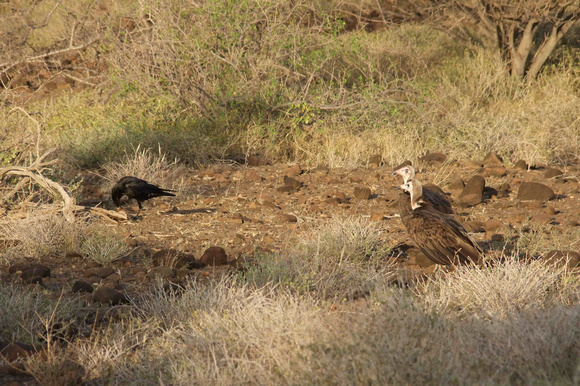
Woken up by echoing bird calls in the first light of the day, I got out of my tent. It was cooler outside and the big fireball was barely above the horizon. I knew it was not going to last, unless the wind is kind enough to bring some clouds. Others were already at the table, waiting for the morning tea to be served. Ravens and vultures were still lingering around, hoping to snatch some scraps of our dinner last night. That was the beginning of my day, as a fossil hunter at Ileret, in the Lake Turkana region.
For people who are city-born and city-dwelling, conditions in Lake Turkana could be harsh. There are a myriad of perils in the wild: thorns, insects, scorpions, snakes and above all, the brutal sun. During the day, the temperature never drops below 30 degrees centigrade, and a piece of shade doesn't make it better. The air is so hot and dry that even if we sweat a lot, we may not notice it, resulting in electrolyte imbalance or heat shock. The key to our survival, as I was told, is to keep ourselves well fed and hydrated. That may sound easy, but it is too often overlooked by those who are new to such hostile environment.
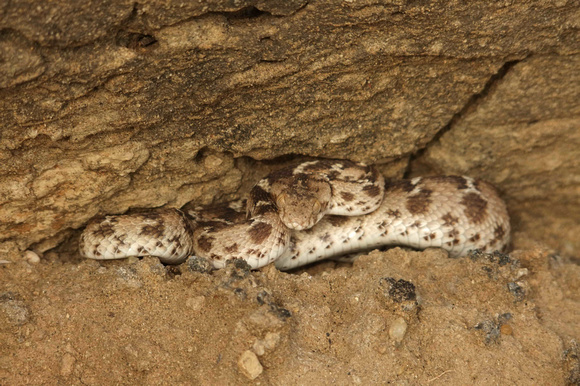
Apart from the relentless heat, other desert dwellers could make our life worse. I was surprised by the overwhelming number of insects at night, despite being in the middle of vast emptiness. Among them were mosquitoes that carry malaria and other blood-sucking flies. There’s never a lack of snakes and scorpions in the Lake Turkana region. I still remember the week during which the team spotted and killed three venomous snakes around the camp. And it was there that I experienced my first scorpion sting right at my thumb top when I was taking a shower in the early evening. The venom caused a continuous stabbing pain in my thumb immediately after I was stung, and the pain soon spread out to my index finger and up my wrist. The pain was overwhelming: I couldn't even sleep without taking a painkiller. Fortunately, the pain lasted for about 10 hours only, so when I woke up the next morning, I was all fine. Although a scorpion sting can cause serious pain, it is generally harmless to human body. However, in rare occasions, it can inflict severe allergy which could be lethal if not treated promptly.
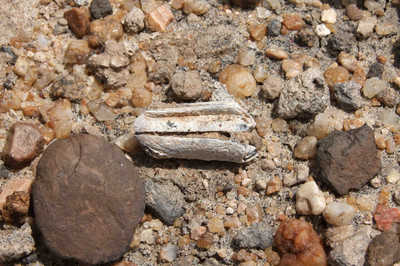

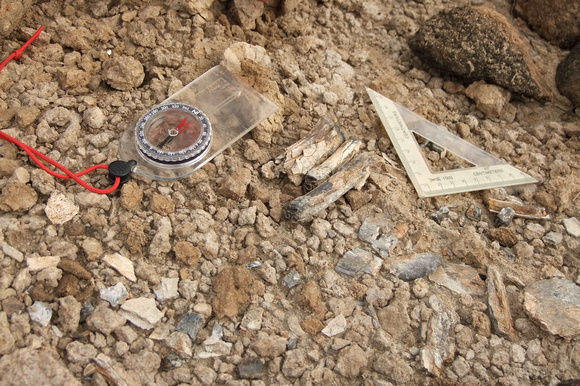
If the overall environment is not intimidating enough, there is more: dealing with rocks of many types and fossils of many shapes. To put it more accurate, we walk over the ancient sediments in the desert, spot out fossil pieces from surrounding rocks, identify the body parts of an animal that the fossils are representing and give taxonomical information to them. If a good exposure is found and fossils are still in situ, we will decide whether to give it an excavation or not. That’s the job of a fossil hunter and it is not easy! I really appreciate the generosity of my fellow colleagues who kindly shared their years of experience. What tools do we use? In addition to our eyes, hands and traditional field gadgets (notebook, pencil, compass, scale, etc ), we use GPS units, digital cameras and palmtop computers for field records. Collecting field information is vital, especially recording the context of where the fossils were found. It helps us to understand how the fossils could have been buried and exposed, so as to recover as many of them as possible. Keeping GPS coordinates of specimens collected over the years helps, too. As more pieces got washed out by rain year after year, we might get parts that belong to the same individual found in the previous field seasons. Most bits of information collected from the field will finally trickle down to a large collection database which keeps the track of every single specimen.
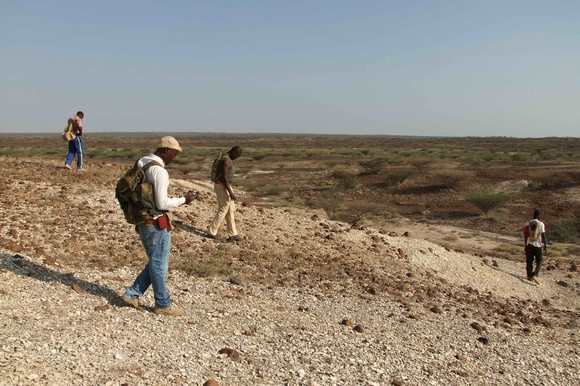
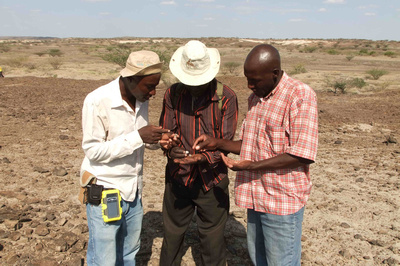
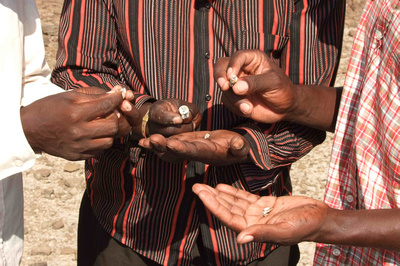
And the best we can hope for is to find fossils of hominins: human ancestors. They are very rare compared with the numerous herbivore mammals, crocodiles and fish. Most importantly, every single one of them may tell the secrets of our distant relatives. I was very lucky to witness the discovery of a few hominin teeth this year. I could immediately feel the strong affinity between the fallen old teeth and myself when I saw and touched those ancient remnants. I felt I was in a time machine, paying a visit to our ancestors who lived a few million years ago. It was fantastic!
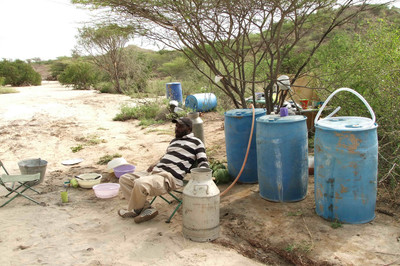
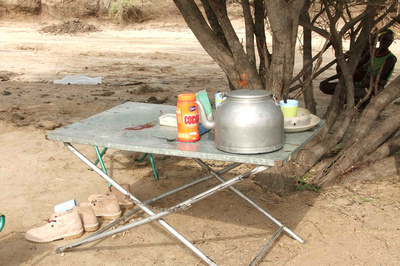
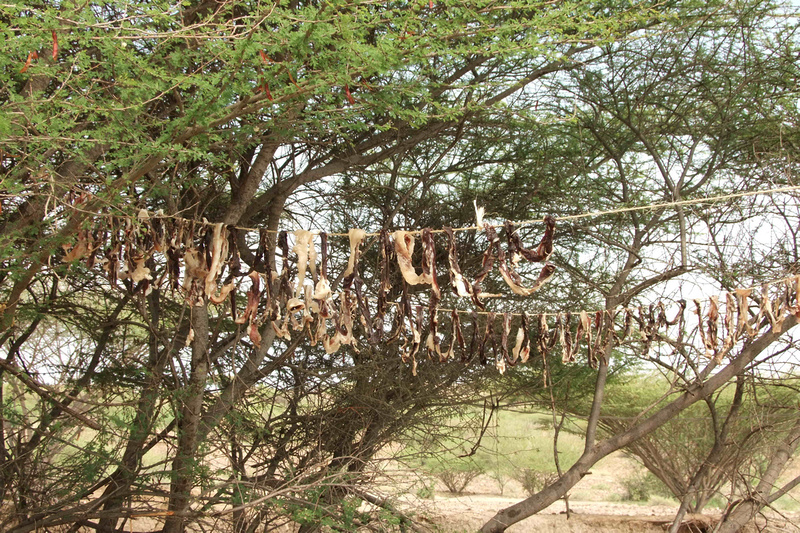
Drying meat in the shade
Hard might the daily seven-hour field work be, handling the logistics of the camp could be even harder. Although the TBI Ileret camp is a real oasis and provides us with a good start, almost everything we used, including food and fuel, was brought from Nairobi 900 km away! The variety of food is always unsatisfactory: usually rice with a stew of beans or meat together with tomato paste and bits of onions. Fresh vegetables and fruits are rare treats in a remote desert such as Ileret. Meat is always welcome, for it gives us strength and energy for such a demanding job. However, a regular diet low in dietary fiber and vitamins not only causes digestive problems, but also weakens our immune system. It happened this year that quite a few of the crew members were sick, including our cook who had pneumonia on top of malaria and was immediately transferred to the local clinic. Although constantly bitten by mosquitoes, I was lucky enough to be out of any trouble like this.

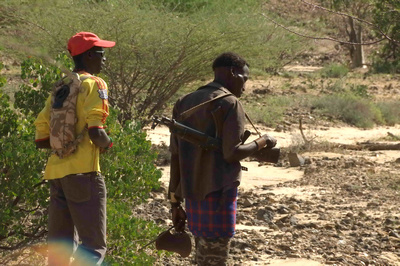
When we were camping at Ileret, we were not alone. Local pastoralists, sometimes with their herds, visited our camp regularly. They even carried guns with them to protect their animals! In nature, however, they were very friendly, bringing in local news and sometimes goats or milk for sale. I could see that they enjoyed the leftovers from our kitchen as well as the drinking water that was provided free.
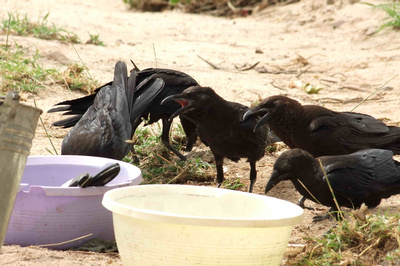
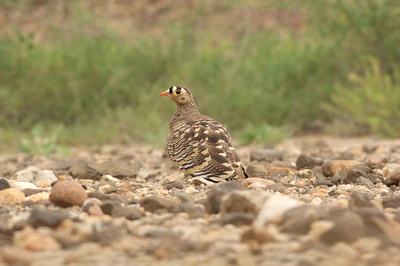
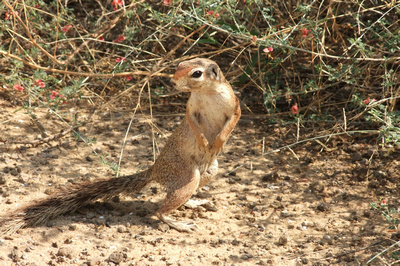
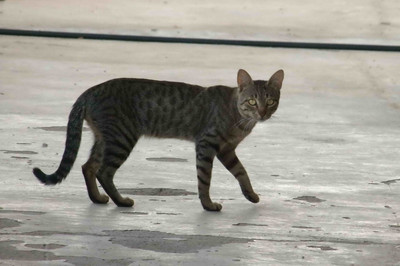
The wildlife in the Ileret area is surprisingly rich. The bushland along the shore of Lake Turkana nourishes birds, small reptiles and mammals of many kinds. While springhares and ground squirrels are common during the day, dik-diks, jackals and even hyeanas are active during the night. There was even a wildcat (Felis silvestris) in TBI Ileret camp! It was seen quite a few times at night, but I was even more fortunate to take a photo of this reclusive creature during the day!
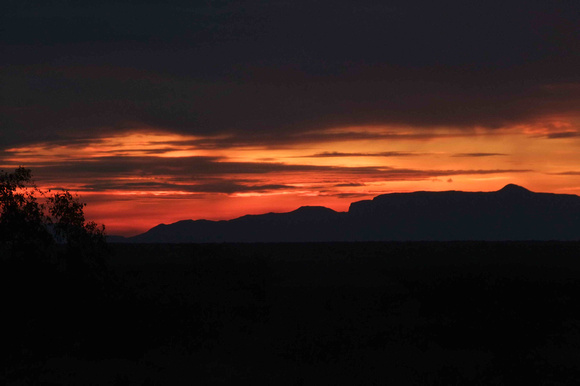
One thing that we never missed at the end of the day was the spectacular sunset. Yet, there was more. On a moonless clear night, there came a full display of the Milky Way. Bright stars and star dust profiled a ribbon stretching across the sky, a scene from time immemorial. It was a luxury only enjoyed by being in the middle of nowhere, but also a grandeur shared by our own ancestors.
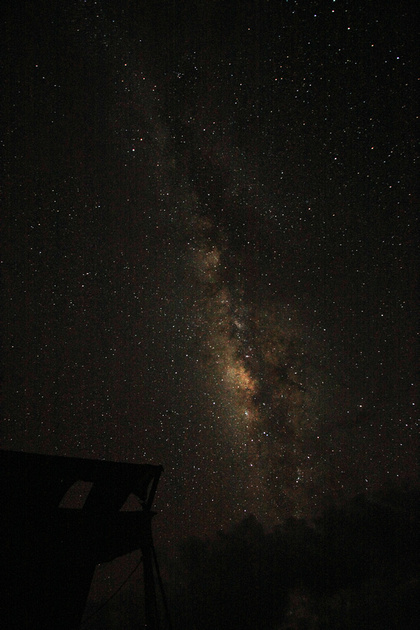
With that in mind, I crept back into my tent, preparing for another day as a Fossil Hunter at Lake Turkana.
PS: Special thanks to Dr. Meave and Louise Leakey who granted me the chance to join the field crew in the field season this year, and to all KFRP field and camp crew members for their support.
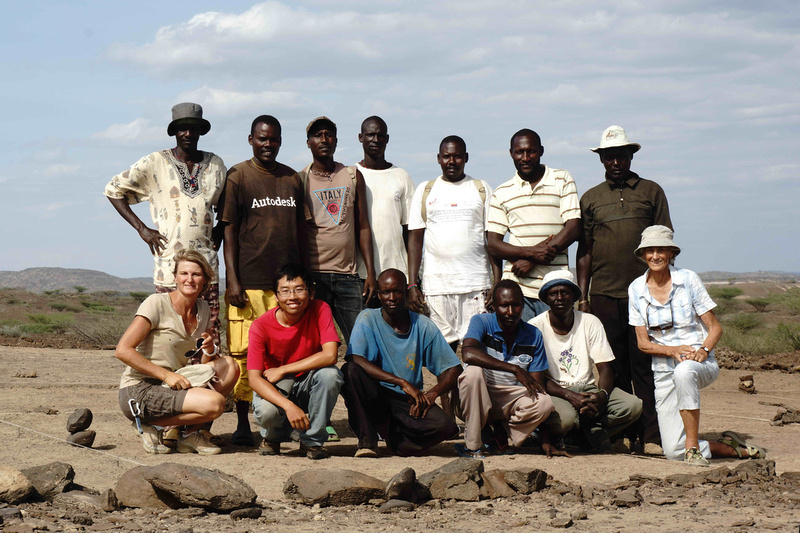
Back: Elgite, Apollo, Shadrack, Lo'ki, Malomalo, Nyete and Arbolo
Front: Louise, Deming, A'bo, Ling'a, Sale and Meave
]]>
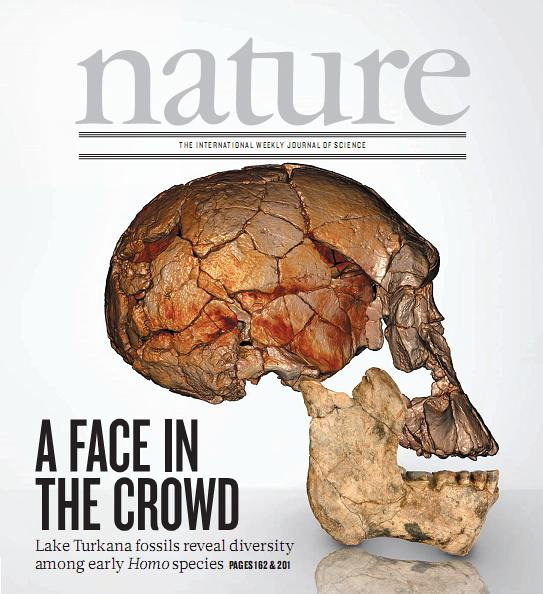
Cover image for this discovery on Nature. See original article on Nature.
The fossils were found between 2007 and 2009 by the Koobi Fora Research Project (KFRP), led by Drs. Meave and Louise Leakey.
The new finds added key evidence regarding the long-lasting debate of how many species of Homo were roaming the East African lands about 2 million years ago. According to this report, it is very likely that in addition to Homo habilis and Homo erectus, there was a third species: Homo rudolfesis. The discovery has significant value in promoting the understanding of human origins and evolution. It might shed light on such questions as what could have happened in the evolutionary history that gave rise to such diverse morphological features within the genus Homo. Another intriguing concern would be how these three closely related species of Homo could have interacted in the company of each other.
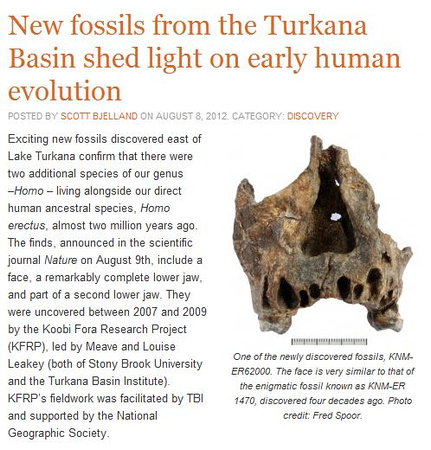
See the official press release article on Turkana Basin Institute’s website.
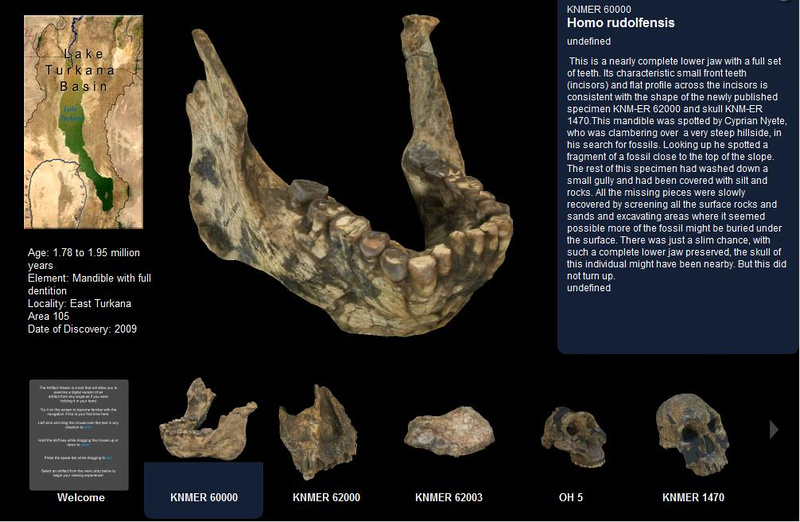
View the new fossils in 3D on AfricanFossils.org.
This announcement has been reported by various news media and websites, and has drawn attention from far and wide. It is my greatest honor to share the delight of this success together with Meave, Louise and the field crew members on the very lands where these extraordinary fossils were unearthed.
It is undoubted that scientists did most of the contributions to our understanding of the past. But here, I would also like to give credit to the field crew members, taking advantage of being able to participate in the field explorations this year myself. It is through living and working closely together with them in the field that I can fully appreciate the importance of their enormous efforts. Indeed, no research could ever be done without their hard work and breathtaking discoveries in the field.
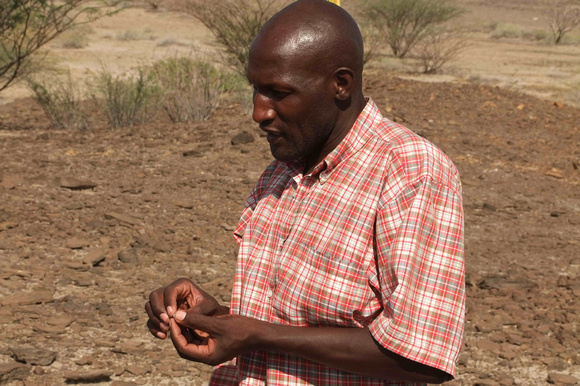
“I’m glad that you are going to write something about us fossil hunters”, said Cyprian Nyete, my colleague and personal friend who discovered that near-complete lower jaw in the 2009 field season. “Very few people know what we do and fewer wrote about our stories.”
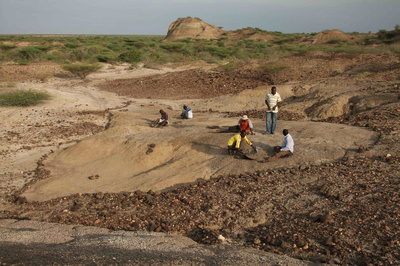
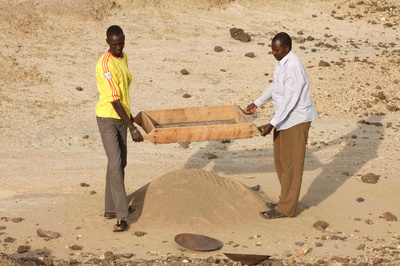
While I am writing here sitting in the base camp at Ileret, a remote town at the Kenya-Ethiopia border, the field crew is still working hard out in the field. The fact that they endure the relentless sun, hostile environment and lots of sand and dust, is the best proof of their commitment to science, to a better understanding of the human lineage.
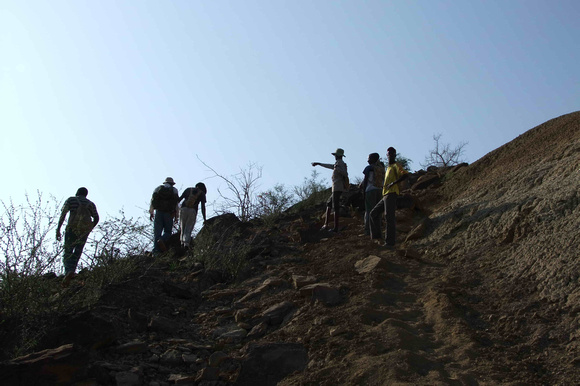
Honestly, I don’t really like the title “fossil hunter” so much, for it gives us a plausible impression of something similar to “treasure hunt”. However, fossil hunting does not have anything to do with the expediency of the fossil hunters. Fossils do have great value but only in realm of science. It is through all the efforts of walking miles on end under the hot sun on the vast fossil bearing areas of Northern Kenya that those fragile fossil remains could be identified and preserved. Otherwise, with constant erosion from the sun, rain, wind and the trampling of frequently passing herders and their animals, even the toughest fossils will perish. The fossil hunters are in fact walking on the front line of the waging war against such overwhelming forces. They are the “fossil savers”. (A following-up article about the life of fossil hunters is coming soon)
PS: Special thanks to Dr. Meave and Louise Leakey who granted me the chance to join the field crew in the field season this year, and to all KFRP field and camp crew members for their support.
]]>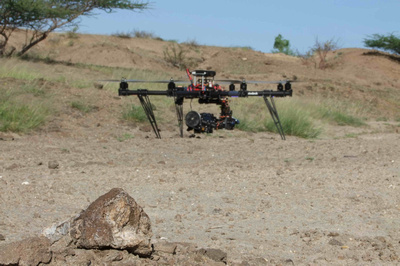
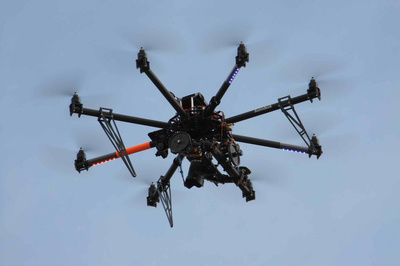
During the past several days of our visit, the Autodesk Octo-copter not only survived the harsh environment of Northern Kenya, but also brought us fresh aerial photography experience, which has inspired the use of new technology in carrying out future field research. With all the missions accomplished at the end of our staying in the TBI Ileret Camp, there was still something in our minds.
We were told that as we carried out field missions, locals had been vigilantly watching the performance of our “flying spider”. For people who have minimum exposure to technology in that remote area, seeing such an eccentric (if not supernatural) object in the sky was certainly an astonishing or even terrifying experience. There were even rumors saying that the machine could cause earthquakes… To dispel doubts and fears as well as to bring the state-of-the-art knowledge to a broader audience, we decided to offer some free shows to the locals.
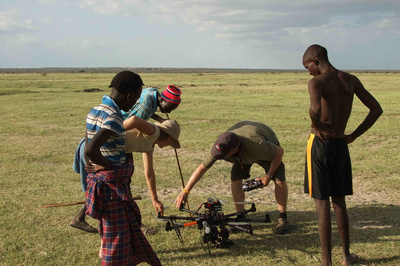
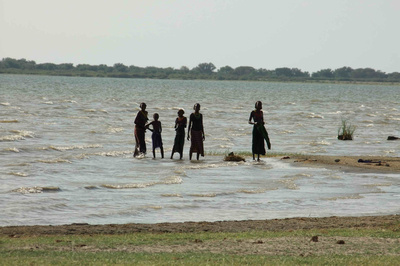
First we headed to the shore of Lake Turkana, where some locals gathered. For people who have done nothing more than herding their animals and fetching from waterholes, having a close look at this weird machine was full of surprises.
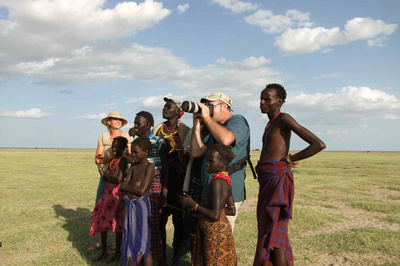
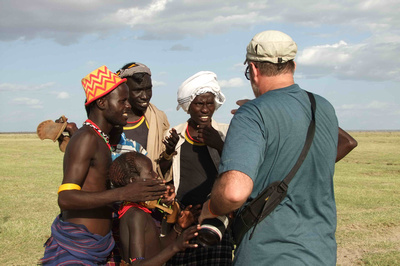
With the help of translators, our expedition leader Louise Leakey and a local who speaks Swahili, we managed to make our explanations from English to local Daasanach language and finally convinced the locals that our intelligent agent would not do any harm to our Mother Earth...
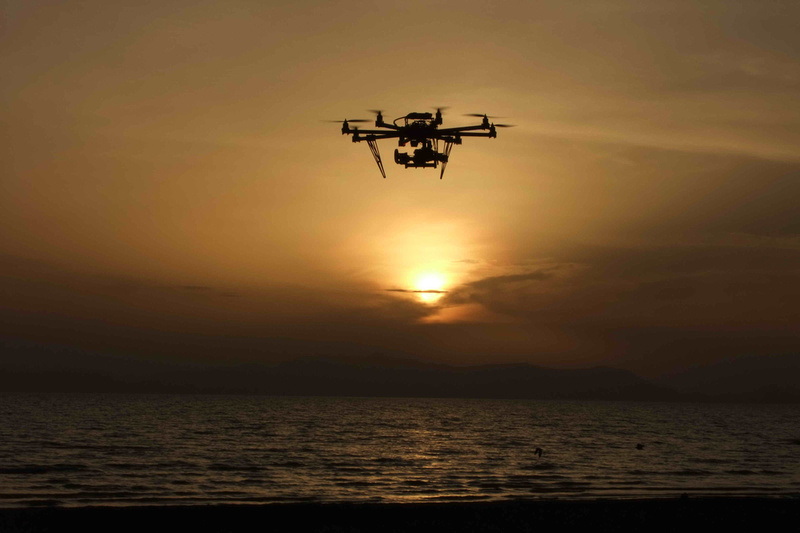
Certainly we didn’t miss the chance of taking aerial videos of a fantastic sunset over Lake Turkana. It was just fascinating!
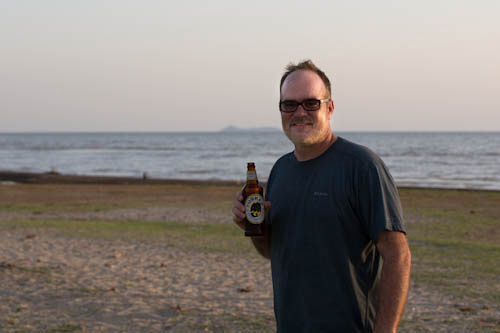
Photo courtesy of Shaan Hurley, Autodesk
And nothing is comparable to having a dip in the lake and enjoying a cold drink on the beach at the end of a long hot day, with cool breezes coming from the Lake and waves gently flapping the shores.
The next morning, we visited a local school with the copter on board our vehicle. The school is situated almost right at the Kenya-Ethiopia border and it is no more than a couple of classrooms, offices and toilets plus a very simple canteen where there are roofs to shelter the kids from the hostile desert sun. There are only two teachers in the school and students of different grades have to share their desks, chairs and even textbooks. It is under these meager conditions that the students are educated, and all of them cherish their opportunities of schooling very much.
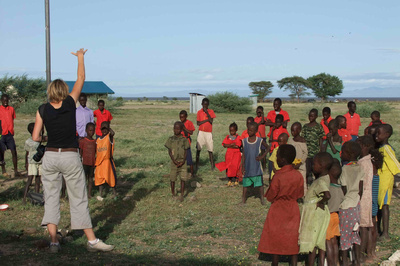
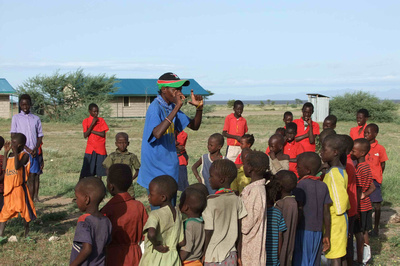
Our arrival certainly raised the anxiety among students. They all gathered in the school yard, listened carefully to us funny looking visitors. And of course, it took all the efforts to explain what the machine was with just simple words.
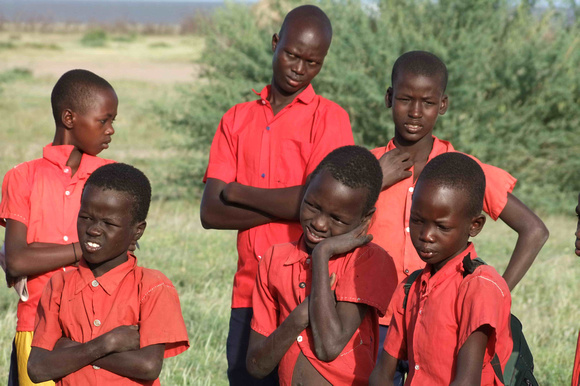
And they couldn't believe it until seeing it with their own eyes. Honestly say, I have never seen kids with such critical eyes!
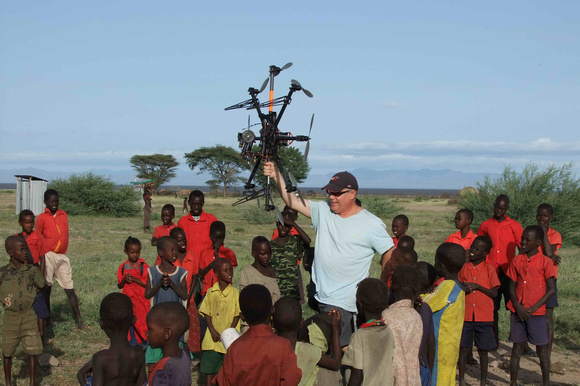
After a brief introduction, there came our pilot Gonzalo Martinez! The big show was about to begin!
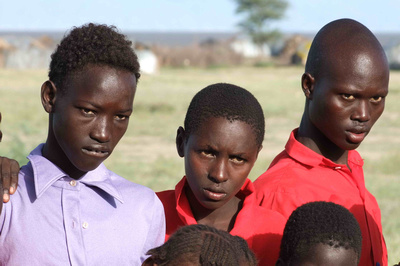
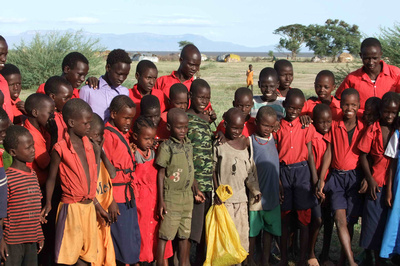
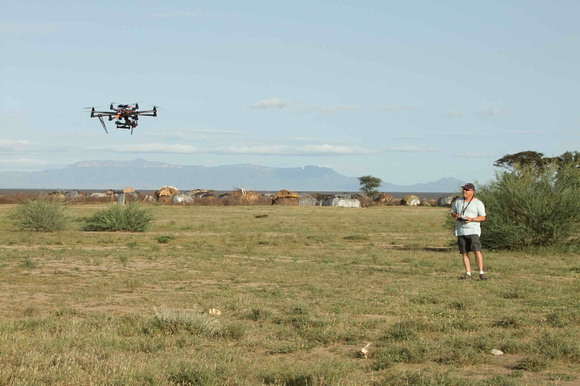
There it was in the air, in the background of huts, Lake Turkana and distant mountains! Unfortunately, the wind there was too strong for the copter, and Gonzalo could do nothing more than keeping it just above ground. But it was still a great performance for the students. After all, that was their first time to see and to touch such high-tech stuff.
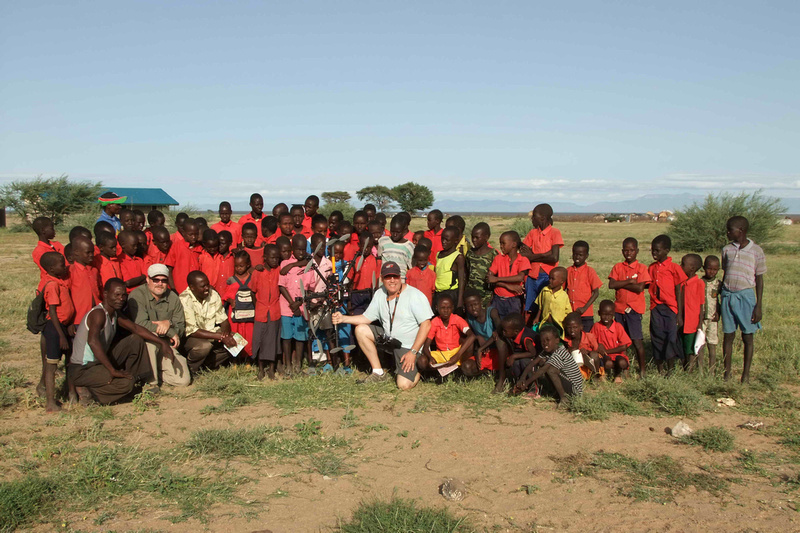
After a group photo with the curious students, we decided to leave some peace to them for the rest of the day. We all hoped that this performance could inspire some of the hard-working students to continue their study and become scientists and engineers in the future, so that they can carry on missions like ours and further promote the understanding of Science and Technology in this and other corners of the world. (The End)
P.S. My special thanks to all the crew members: Louise Leakey, Gonzalo Martinez, Shaan Hurley and all staff from TBI Turkwel and Ileret, for your full support and care during the whole length of the visit. It was my greatest honor to work together with you, to enjoy the expeditions and teamwork!
View and download photos of this post: Flying missions
Aerial Video edited by Gonzalo Martinez, taken from the copter.
A Slideshow of "Flying Missions in a remote desert: In search of our ancestral trails"
]]>
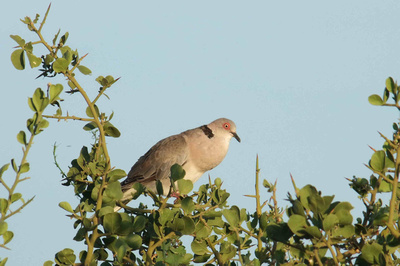 Welcomed by the earliest birds, we started our first morning in Ileret: a remote area to the east of Lake Turkana, almost at the Kenya-Ethiopia border.
Welcomed by the earliest birds, we started our first morning in Ileret: a remote area to the east of Lake Turkana, almost at the Kenya-Ethiopia border.
The Ileret area is very rich in fossil exposures. Near the TBI Ileret Camp, there are several sites where Pleistocene hominids or Holocene human remains have been recovered. Among them are some of the rarest fossils ever found: fossil footprints of animals and early humans. Recording not only the shape of early human feet, the foot prints also offer clues to a long lost scene: hominids walking in groups. Rather like a snapshot in the eyes of paleontologists, they provide a unique perspective for the study of early human behaviors, adding colors to the whole picture of human evolution.
For people who dig for fossils in the Lake Turkana area, work begins before the first light breaks out of the horizon. Here in the tropical desert, the brutal sun can easily subdue anybody through heatstroke and dehydration, let along quite a few other perils such as thorny bushes, formidable scorpions and venomous snakes. Therefore, mornings and evenings are the sweet hours of the day, while there is pretty nothing to do in the middle of the day but to rest in the shade. That worked for our team as well. In addition to such limits, we had to submit to yet another dictator: the wind!
We thought that the experience of windy weathers we had in Turkwel and Lothagam was pretty enough. Unfortunately, the temper of the wind in Ileret was even more unfathomable. The wind is ever gusty in Ileret during the day time and there is hardly a moment when the air is calm. The situations only got worse when we were out in the field, where there is less vegetation coverage. The only window of opportunities for our drone was either in the early morning or in the late afternoon, when the wind was just a bit calmer. That was still quite a challenge for Gonzalo Martinez, our pilot of the remote controlled copter, even as experienced and skillful as he is.
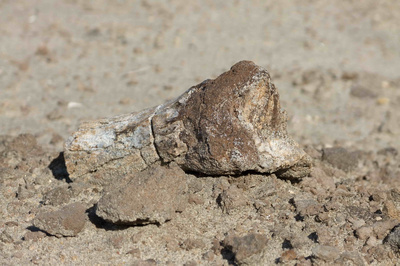
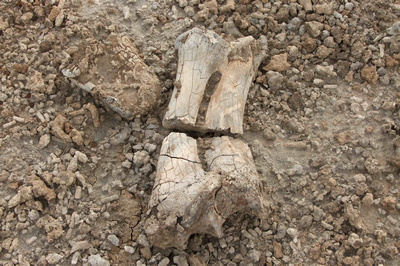
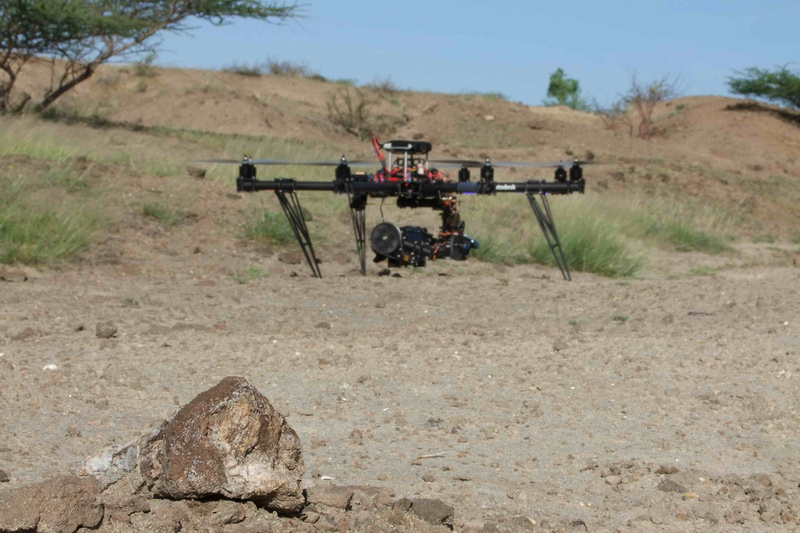
Under such field conditions, we brought our intelligent agent to a fossil site near the base camp. And it is really a rich site! As we walked through the terrain, we found many pieces of fossils just on the ground. Some were fish bones, turtle shells and crocodile teeth, indicating that the area was once under water. Others were mammal bones and teeth of different genera and sizes, preserved in the lake sediments. Although noticeable or even conspicuous, most of the fossils there were either fragmentary or unidentifiable, therefore, not so much worth collecting.
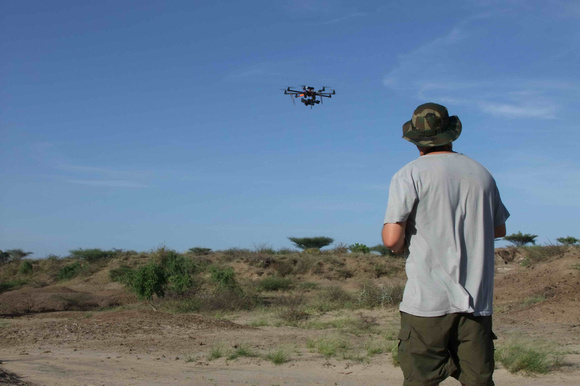
And there, we started our search for fossils, not on the ground, but in the air! How? Simply put, we took aerial photos from high up and then zoomed them in on a computer screen to see if there is anything interesting lying on the ground. The same trick as we did on the Lothagam stone circles.
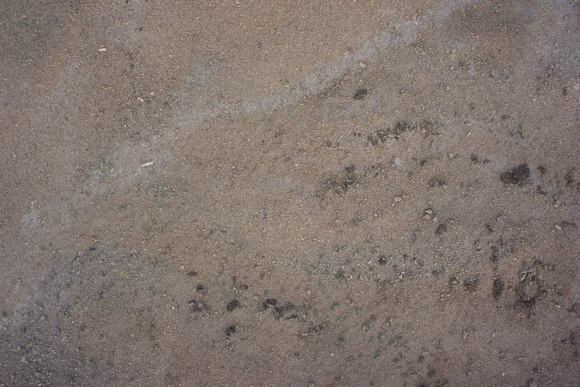
Photo courtesy of Gonzalo Martinez, Autodesk
However, even though there were many fossil pieces on the ground, the aerial photos did not come out very good. It worked okay with big fossil pieces, such as long bones of medium-sized animals. But the resolution of our images was not high enough to distinguish small fossil pieces from the stone scatterings.
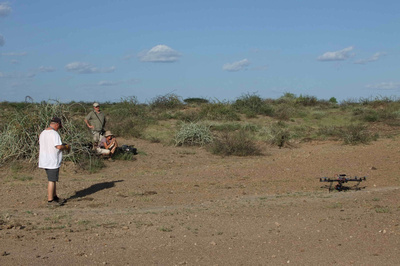
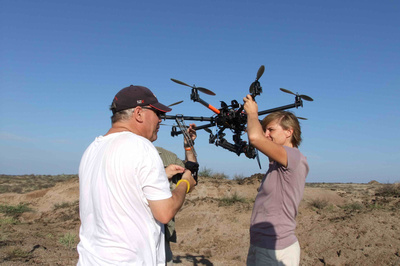
Trying to push the limits of our “flying spider” as well as the cameras we had, our expedition leader Louise Leakey suggested another test flight on an even richer site in the afternoon. Instead of a Sony NEX-7, we had a Canon 600D (Rebel T3i) with an 18-55mm kit lens on board to do the photography. This time, we had some technical problems from the camera and even though we did solve them in the end, the results were not better. It seemed to us that the entry-level cameras we had, represented by the Sony NEX-7 and the Canon 600D, either do not have enough pixel counts, or do not have quality lenses that enable us to do relatively detailed surveys from the air.
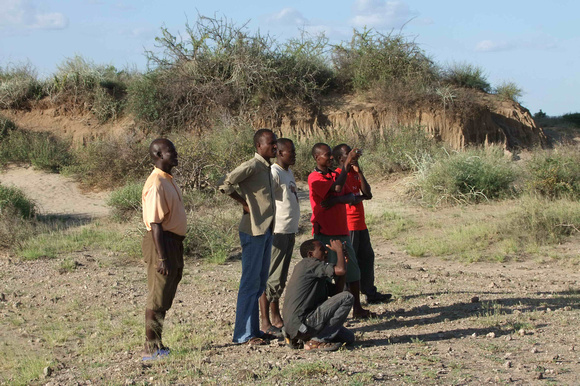
The field survey team was with us, too. They are the real people who walk miles on end in such areas and search for fossils on regular bases. It was the first time for them to see such high-tech equipment working out in the field. They were all very excited about how technology could possibly change the way of doing field research in the future.
Missions failed? Well, at least, we tested the machine on the spot and understood what the problems were. And the Lake Turkana area did teach us a lesson about how unpredictable the real field conditions could be. Next time, if possible, we could try a drone that can handle the wind much better than the Octo-copter and can carry a professional level camera plus top quality lenses on board. As the technology advances and the cost goes down, such equipment could be available in a few years’ time, when we might have a more labor-saving way to doing field surveys in a harsh place such as the Lake Turkana region. Our pioneer of technology Shaan Hurley, from Autodesk, was very confident about that.
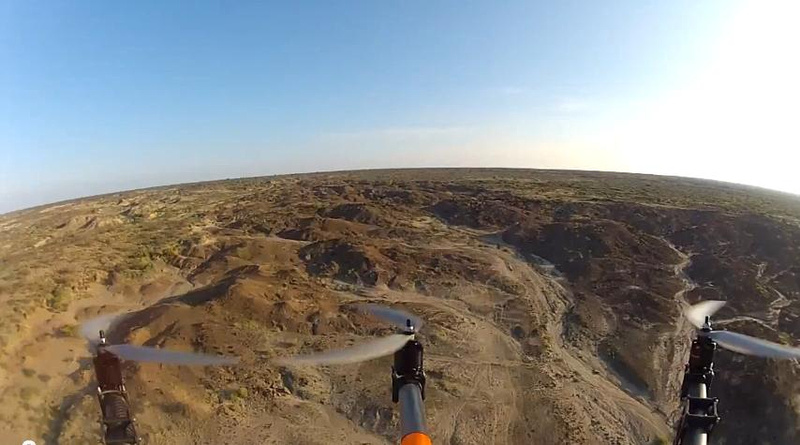
Although photos did not work very well at these sites, we could still shoot aerial videos around the fossil sites. In addition to the Sony NEX-7, Gonzalo had a GoPro camera which could be fixed on top of the copter. It offered an extra wide angle of view, distinct to that of the Sony NEX-7 mounted on the articulated frame below the copter. The most obvious difference was that there were always three propellers of the copter seen in the frame, which makes the viewers feel that they were sitting in the copter themselves. Very cool, indeed! Aerial Video edited by Gonzalo Martinez
Is this the end of everything? No! Science and technology are of great fun, too! Being grateful for the invaluable experiences we had in the field, we were all ready to share them with others, especially the locals in Ileret. A lot of stories to tell! (To be continued)
View and download photos of this post: Flying missions
]]>
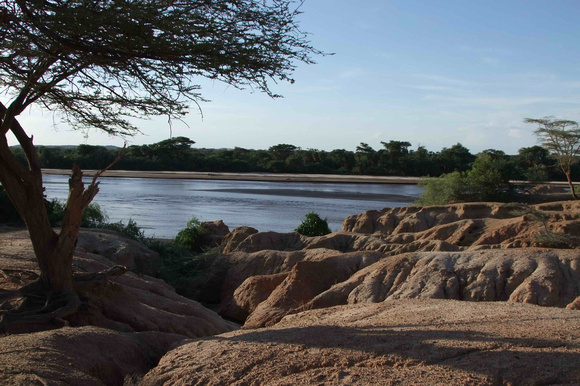
According to the schedule, we were going to leave Turkwel the next day and head north to Ileret on the east bank of Lake Turkana where we were going to carry out the second half of our mission. The last day in Turkwel camp! I knew I was going to miss there! It is such an oasis in the middle of the desert, and definitely a paradise for researchers! Shaan Hurley, our computer engineer and photographer from Autodesk, and I decided to have a little dip in the quietly flowing Turkwel River, for the last time of our visit.
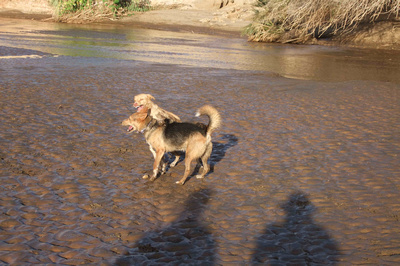
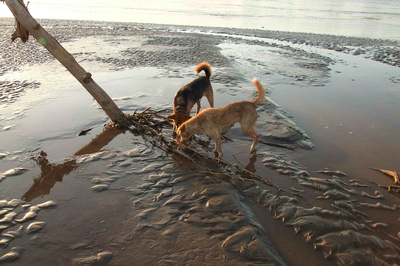
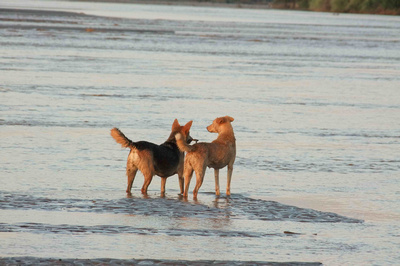
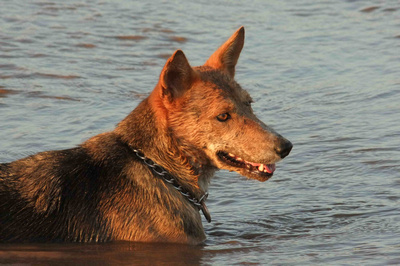
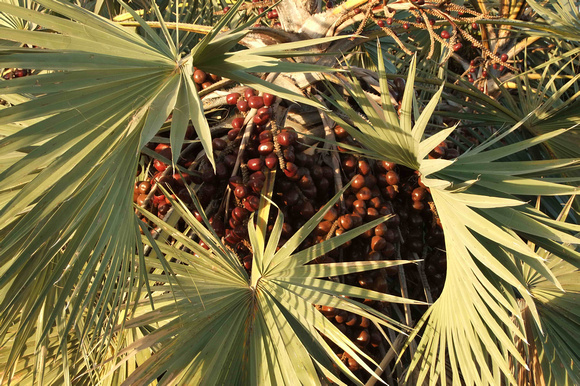
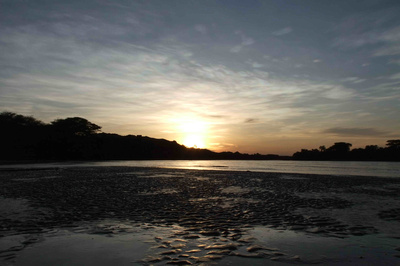
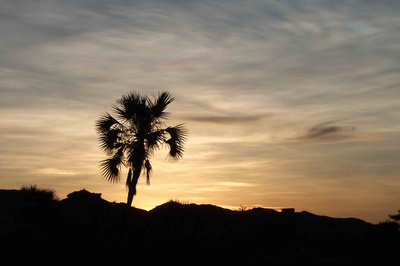
Probably it was the remoteness of this wild place that stimulated our satisfaction and joy. There is pretty nowhere more tranquil than Turkwel. The only sound we could hear was from the wind and the flowing river. Completely cut off from the hustle and bustle of civilization. The unfailing beauty of sunset was another plus! Just splendid! We really had good time that day, like little boys.
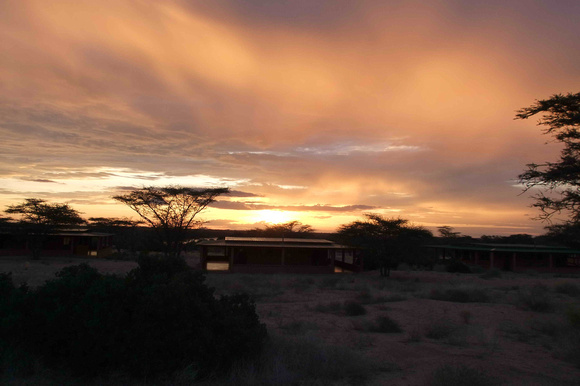
The next morning, Turkwel amazed us again with a spectacular display. But our schedule didn’t allow us to linger. At about eight in the morning, after packing all the things, our camp manager and pilot Dr. Louise Leakey, Captain Gonzalo Martinez and Shaan escorted the Autodesk copter to the closest airstrip. Ileret is on the eastern bank of Lake Turkana and is further north, almost at the Kenya-Ethiopia border. The fastest way to travel from Turkwel to Ileret is by air, flying over the belt of jade. Alternatively, a road trip would take about 3 days…
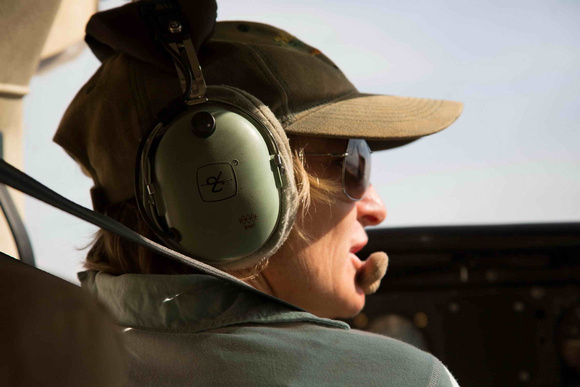
Our Pilot Dr. Louise Leakey Photo courtesy of Shaan Hurley, Autodesk
Because of the bulky cargos needed to be transferred, Louise had to fly twice in a day to bring everybody and everything up to the east in a Cessna 206, a six sitter small plane. And I was on the second flight, after Gonzalo and Shaan. The job was very demanding for Louise, being the manager of both Turkwel and Ileret camp.
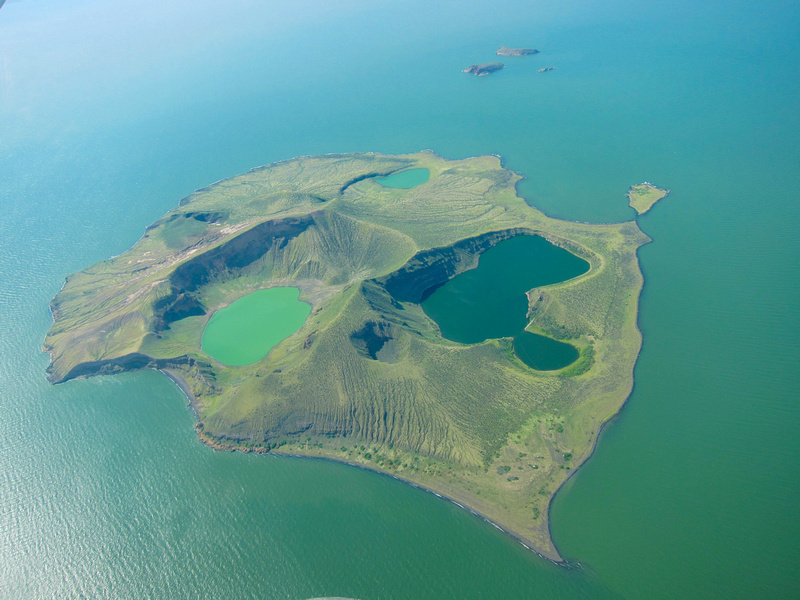
Central Island of Lake Turkana Photo courtesy of Shaan Hurley, Autodesk
Lake Turkana is the largest desert lake in the world. Flying over it offers an exceptional view of the beauty and exuberance of the life-giving water body. Patches of green and blue represent the flourishing algae, which feed a colossal number of fish in the lake, and eventually people who live on them. Fresh water from the Omo and Turkwel River is the life line, creating river deltas in lush green. Smaller river channels nourish a huge span of bushes and grass, attracting animals of all kinds, including pastoralists and their herds. The landscapes were so green and prosperous at that time that they overturned my previous impression of the same desert.
However, the lake is shrinking because of the increasingly dry climate. Rings of beach lines are clearly visible from the air, defining the prior boundaries of the lake. A dam is being built on the upstream of the Omo River, which may result in a reduction of its in-flow. Lake Turkana, a lake that has witnessed the first steps of human ancestors, a lake that has nourished animals of all kinds, is at risk of drying out…
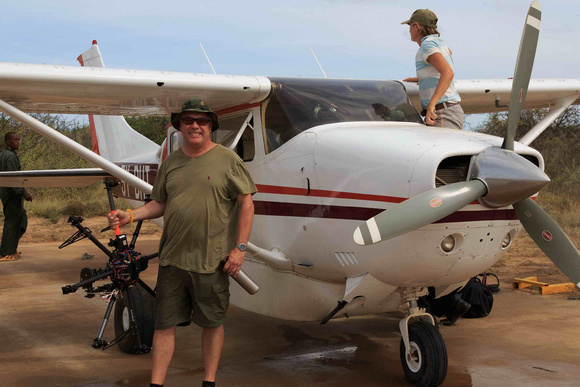
Gonzalo at Ileret airstrip Photo courtesy of Shaan Hurley, Autodesk
By about three in the afternoon, we were all at TBI Ileret camp, about 5 kilometers from the lake shore.
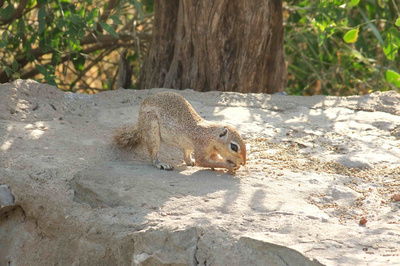
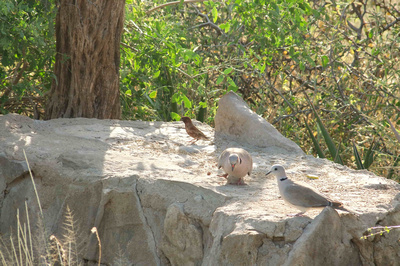
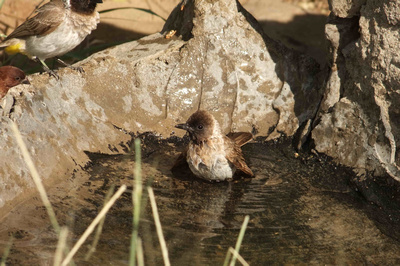
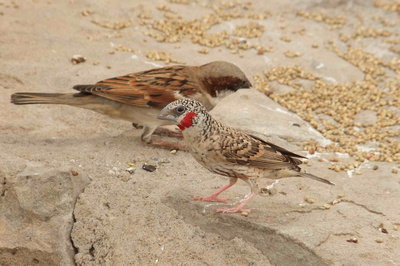
Although not so much active under the relentless sun, the rich wildlife in the camp still surprised me. Built among thick bushes, the camp is the heaven for a large variety of birds and some small mammals, including a pair of ground squirrels, Xerus rutilus. And what could be more attractive than a small pool of water that even allows baths, plus feasts of millet?
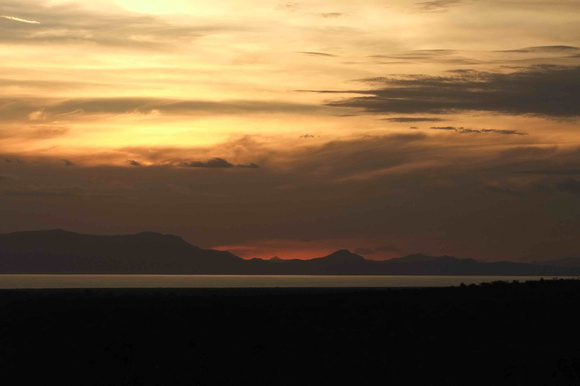
As the day came to an end, our eyes were again spoiled by the magic of wilderness. First the sunset. The diminishing anger of Apollo created the color of an inferno. Then the Milky Way! Stretched across the pitch darkness. With an arch of new moon, hanging low above the silver calmness. A grandeur that only exists in our wildest dreams, but so real in front of us!
Compared to Turkwel, insects in Ileret were even more rampant at night! Some may even fall into our dinner plates or end up in our water bottles. No worry about a low-protein diet… It was there that I had my first taste of a stink bug, of course without notice… It was quite crunchy but the taste was extremely unpleasant…Camp paths became super highways for insects such as ants and beetles. And it was almost a routine to meet some scorpions, spiders and monstrous crickets outside of our tents everyday… Surprisingly, there were toads out there, too. Really a tough place for amphibians!
In a symphony of insect callings, I went to bed, hoping that the missions of the next day will be as smooth as butter. :) (To be continued)
View and download photos of this post: Flying missions; Ileret, Lake Turkana; TBI Turkwel
]]>
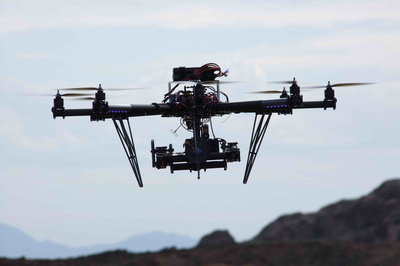 Released from the breathtaking copter crisis which almost caused a tragic crash, we all thanked the designers of this intelligent aircraft. For our dedicated captain and pilot Gonzalo Martinez, it was his first time to experience that, too. Having the Sony NEX-7 which recorded everything in HD video, he carefully explained the causes of the crisis.
Released from the breathtaking copter crisis which almost caused a tragic crash, we all thanked the designers of this intelligent aircraft. For our dedicated captain and pilot Gonzalo Martinez, it was his first time to experience that, too. Having the Sony NEX-7 which recorded everything in HD video, he carefully explained the causes of the crisis.
From the screen, we saw all the details of the incident. First, the copter hit a current and was blown to one side with tremendous force. At that time, Gonzalo was trying to balance the copter but he simply could not. Then we saw the copter swung to its left, tilting at an angle. It was so helpless in the strong wind that it almost crashed on the cliffs, only narrowly escaped from the bushes below. Without doubt, it was the gusts that triggered the incident. When all controls failed to compensate the gales, our captain activated the automatic mode. Then the copter started to behave in a different way. It first climbed straight up to the altitude of about 100 meters and successfully got out of the turbulent! Against the headwind, it slowly came towards the hills where we stayed, and finally we had it back! How extraordinary! We were all impressed by the versatility of this machine, which enabled it to deal with such an emergency totally beyond our helps.
Although we almost lost our reliable robotic unit, we gained the HD video of the stone circles! Invaluable footage out of the adventurous flight! And it is crystal clear! A success after all!

As we talked about the incredible quest of the copter, our field leader Louise Leakey suggested that we should all go and see the stone circles, since they were not far away. Indeed, a bit of walk around this lunar landscape would be a good way to relax our over-tightening nerves. And from there, with water bottles in hand, we started our expedition through the alien terrain of Lothagam.

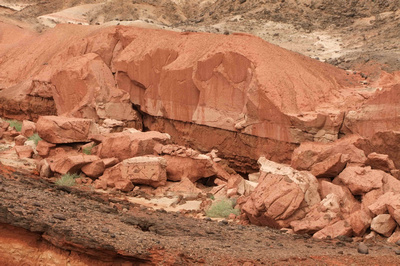
Wondering in this glorious geology museum, we were all stunned by the power of nature. Over millions of years, layers of ancient sediments have been eaten away by water and wind, leaving cracks and crevasses on the ground. Draining rains cut out even bigger channels, depositing sand and pebbles at the bottom of the valleys. The winding gorges and reddish sediments reminded Shaan Hurley, our “Minister of Cameras & Computers”, of Southern Utah in the United States.
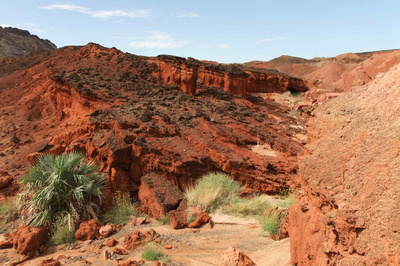
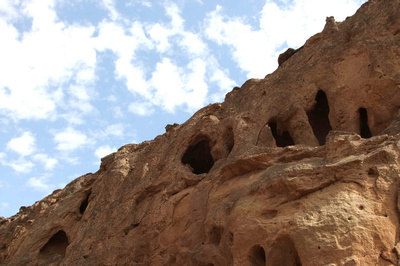
However, the seemingly barren place is not devoid of life. A few green pioneers have anchored their roots deep underground, sucking precious water avariciously. On the cliffs of sandstones, birds have claimed their presence by digging out nesting burrows, sheltered from the parching sun. The only land mammal in sight was Homo sapiens, including a few local Turkana people. It was a big surprise to see them in Lothagam, since it is far from any water source. Undoubtedly, life is tough for all who live there.
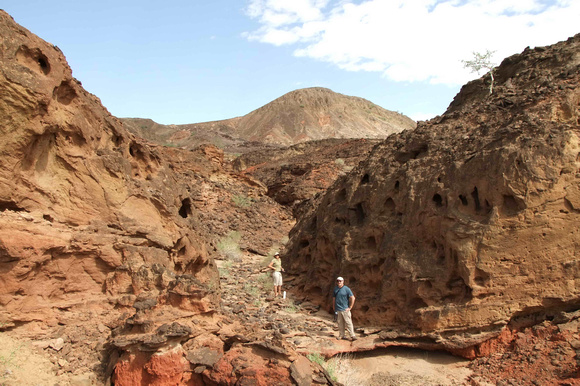
Hiking over the rugged terrain of Lothagam was a lot of fun, despite the overwhelming heat. Sometimes, getting proper footholds in loose deposits and steep slopes could be a challenge. A switch to “4-wheel-drive” might be a good idea. An interesting way to experience our connections to other land mammals, or just a new way to stretch our arms and legs…
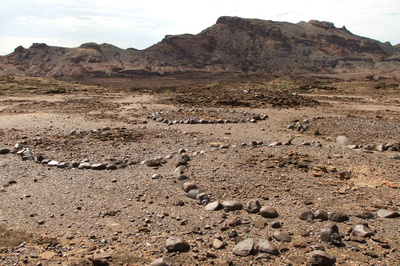
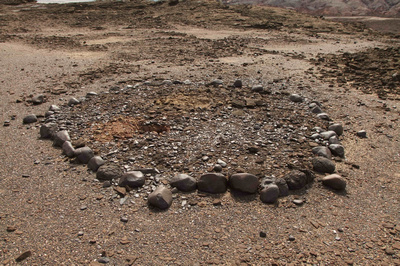
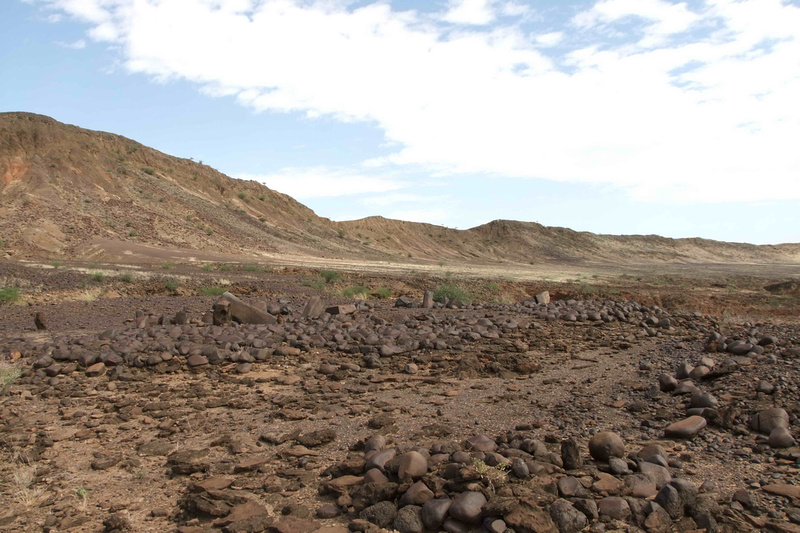
By the time we finished our exercise, we found ourselves on a relatively leveled platform overseeing the valleys. And our first sight of the ancient remains! There are several stone circles and several other flat stone mounds huddling together, ranging from about 5 to 10 meters in diameter. These stone constructions are believed to be human settlements and memorial sites about 10,000 years ago, when the lake water was about 80 meters higher than the current level, high enough to reach where we stood. This fact is crucial in understanding the context of these ancient architectures. Living at the lake shore back then, people who built these settlements would have enough resources to sustain such complex structures, both for social and cultural purposes. In the past few decades, stone tools, bone spear/harpoon heads, turtle shells and numerous fish bones have been excavated in the surrounding sediments, indicating a fishing-hunting-gathering lifestyle of these early settlers.
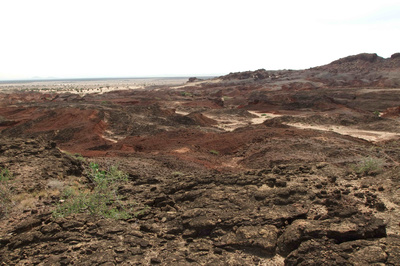
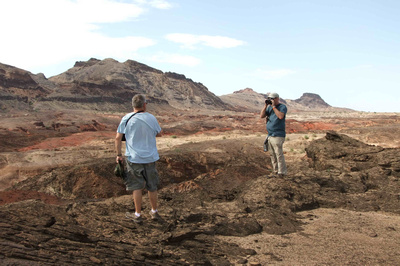
Certainly a great site for archaeologists, it is also a fantastic site for photographers! Having the grand views of valleys, outcrops and bare rock beds in our cameras was a heroic triumph! A good moment for snapshots, too, especially in the strong wind blowing from down the cliffs. There was nowhere else to enjoy such a refreshing service! Oh! Wait! That was the cause of the incident!!! :P
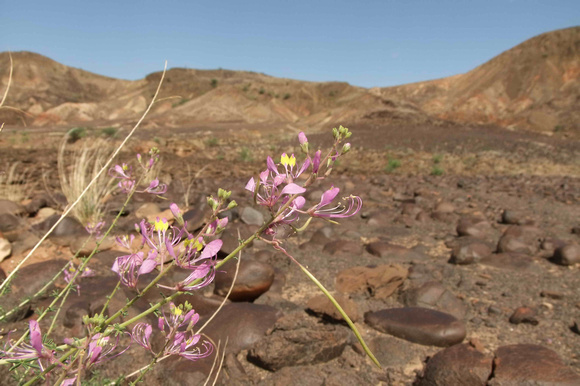
Looking at the ruins with our own eyes, our understanding of past raised to a new level. Standing on the same place where people walked, touching the same tools that they used about 10,000 years ago, we could feel the links between them and us, at least vaguely. Archaeological studies are rather like detective stories. With limited clues available, it is usually difficult to search for connections of the fragmentary past. The more evidence we have, the clearer the picture would be. And this was the ultimate goal of our visit: to add more pieces to the entire jigsaw puzzle of human origins.
With these thoughts in mind, our captain decided to take another risky move. Although the copter might not handle the gales well at the end of the platform, it could certainly fly above the circles, where the wind was relatively gentle. But the copter had to take off from where we stood, for better controls and a longer period of hovering. A new mission! To go back and bring the copter plus all gears to the circles! Not easy at all!
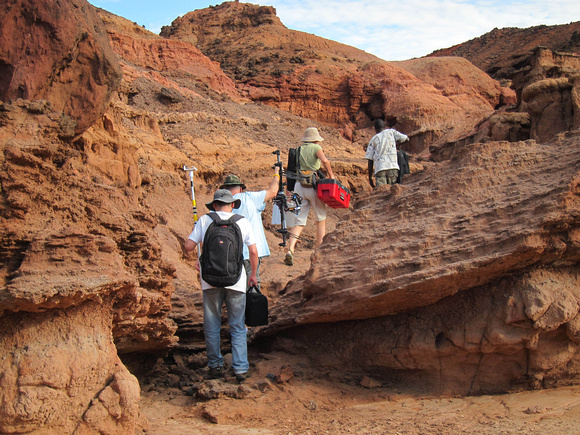
Photo courtesy of Shaan Hurley, Autodesk
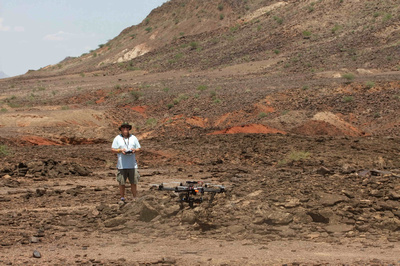
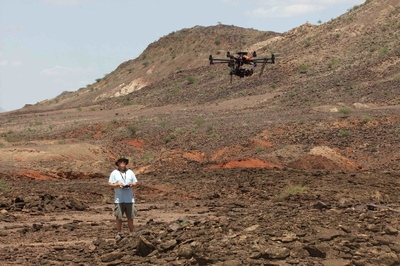
Having overcome the rough terrain, dehydration and heat almost comparable to sauna, we were back on the platform again with everything. But this time, we were going to do still images only.
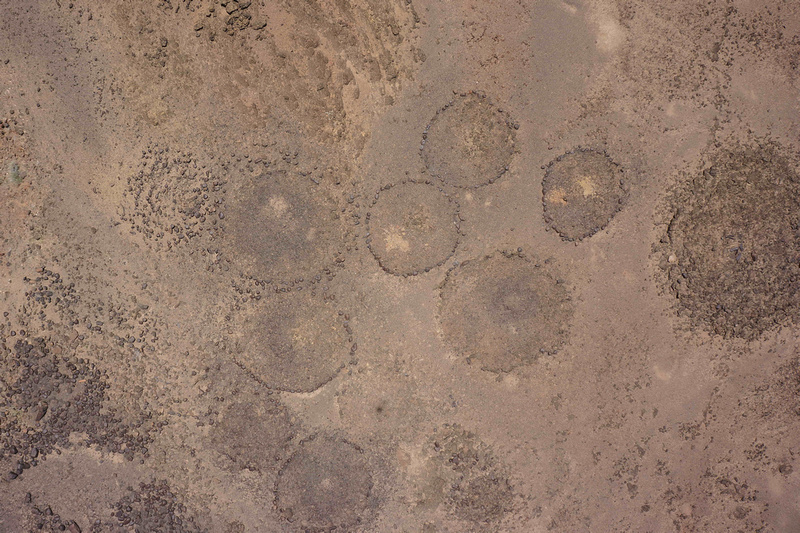
And this is one from the air! Bravo! Photo courtesy of Gonzalo Martinez, Autodesk
After all the efforts of acquiring aerial images above the stone circles, it was already one o’clock in the afternoon and the temperature was approaching 40 degrees centigrade. Exhausted and hungry from the demanding but successful missions in Lothagam, we jumped onto the vehicle and headed back to TBI Turkwel Camp, where food and drinks awaited. (To be continued)
P.S. My special thanks to all the crew members: Louise Leakey, Gonzalo Martinez, Shaan Hurley and a collection manager from TBI Turkwel (my apologies for not remembering his name), for your full support and care during the expedition.
View and download photos of this post: Lothagam Landscapes; Flying missions
Aerial Video edited by Gonzalo Martinez, taken from the copter.
Related blog posts by Shaan Hurley
For more information about the stone circles, please visit this webpage by Elisabeth Hildebrand, Stony Brook University.
]]>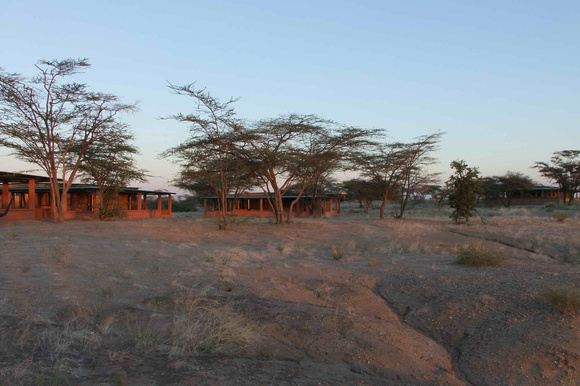
The tests on the second day of our mission turned out very successful. The aerial videos we obtain from the Autodesk Octo-copter were fabulous, capturing the splendid landscapes around the Turkwel Camp. More importantly, we understood how this machine could help us with field surveys on the ground: secrets of ancient remains are often disclosed from another perspective and our copter could certainly offer that.
As we all looked forward to the debut of our intelligent agent in the field, the night fell. Tied up to the logistics and power shortage, still not so much used to a shower of bugs and the penetrating heat even at night, we only had little sleep but had to get up at 5 in the morning, when it was still pitch dark. It was a race against the parching sun, one of the most hostile things in the desert. The golden time for any field operation in Turkana is either early in the morning or late in the afternoon. There is simply nothing we can do but rest in the middle of the day. Nobody would afford having a heat shock in the desert, neither would our gears.
After a brief breakfast and check-ups of all apparatus, at the first light of dawn, we headed to Lothgam, a Miocene fossil site ~40 km to the southeast of TBI Turkwel Camp. It sounds not far away, but carrying a sophisticated machine with all kinds of electronic devices and on rough roads, we couldn’t go fast. Our field leader and driver Louise Leakey was well aware of that. The trip turned out a two hours’ drive and by the time we arrived, the sun was already well above the horizon.
Lothagam is known for the abundance of its paleontological evidence of the late Miocene period, about 5.5 to 8 million years ago. Thousands of fossils specimens have been uncovered in the last four decades. Having looked at some of the Lothagam materials myself, however, I never expected that this site could be so alien!
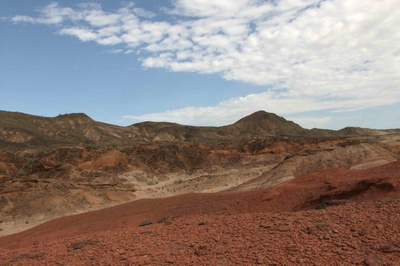
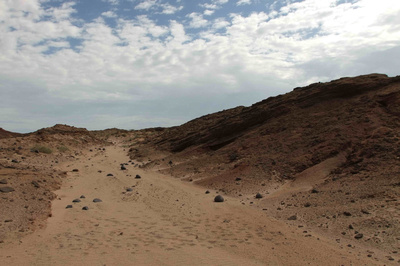
Reddish terrain dotted with black volcanic rocks, exposed and shaped by primeval forces. Some of the iron-rich sediments have been chiseled away, leaving winding gullies and gorges.


Looking at the martian landscapes of Lothagam, we felt as if we were standing on the surface of another planet. Only the blue sky, white clouds and a few green pioneers could give away our tie to mother Earth.
Animal remains in the sandstones tightened this connection even more. As we walked around, we found quite a few fossil fragments scattered on the surface of ancient sediments, preserved and revealed by the power of nature itself. For years, the land we walked on was submerged under the lake water, but now, the lake shore is far beyond our sight. A few million years, long enough to bear such dramatic changes, long enough to turn the alive into rocks, is only a blink of time in the geological history.
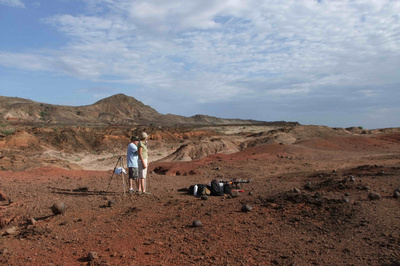
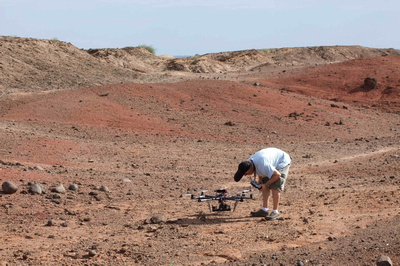
This time, however, we were not going to decipher the encrypted stories of the past. We were going to fly! Settled on top of a small hill, we put up all gears and prepared for our first flight. Our targets are the remains of human settlements: stone circles in various sizes, about 10,000 years old. Since we did not settle near the circles in the first place, our captain and pilot Gonzalo Martinez decided to fly with his virtual reality goggles and search for them from the sky! With the capability to cover a large area from high up, the copter is our airborne scout!
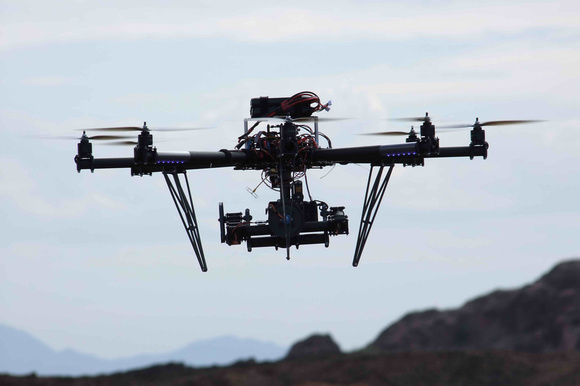
Under moderate wind, the copter took off following the directions given by our expedition leader Louise. It is very easy to lose orientation in a labyrinth like this, especially for recruits such as the rest of us. Her experience was vital for the whole crew to survive this hostile environment.
As the copter went far, we could only see it as a black dot moving in the blue backdrop. The sound of its motors was totally drowned by the blowing wind. After a few rounds searching, our captain Gonzalo spotted the stone circles from his goggles. The copter was right above the ancient structures! It was his first time to see archaeological remains from the air. With a Sony NEX-7 on board, we were all expecting the first aerial video ever recorded in this place.
However, when the copter was turning back, something unexpected happened. All of a sudden, the copter swung to the left as if dragged by an irresistible force. Directed by the steep slopes, the wind on the hillside formed a powerful turbulent, stroke the copter hard. The gale was so overwhelming that no matter how hard our captain pushed the joystick, the copter was still unable to fight against it. Just at the same moment, harsh beeps came out from the remote controller. WARNING! The copter was under low battery! If it failed to land in a few minutes, a crash would be inevitable! But the copter was still a few hundred meters away, struggling back against strong headwind. “We are going to lose it!” So did our captain say…
When all magic of our machine seemed to be gone, our captain activated an automatic mode. Carrying a GPS component, the copter records the coordinates when it takes off and can come back to the same place automatically. That makes the “flying spider” really intelligent, but it was certainly the last thing we wanted to do.
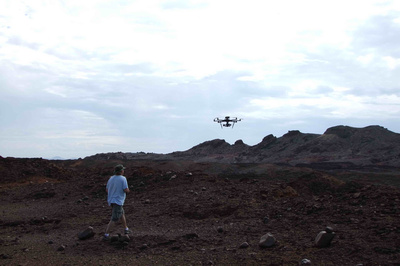
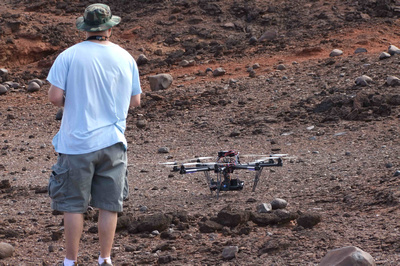
Acting all on its own wills, the copter started to climb and successfully got out of the turbulent. Slowly by slowly, the black dot grew bigger and bigger. Against all odds, it came back! Under manual control again, the copter finally landed in one piece!
After the last few minutes of the breathtaking flight, it was a huge relief for our captain Gonzalo to have the copter on the ground, safe and sound. Although the first field operation of our air force unite almost became its last, it showed its reliable strength and stamina. Kudos to the copter and the captain! (To be continued)
View and download photos of this post: Lothagam Landscapes; Flying missions
Aerial video by Gonzalo Martinez, taken from the copter.
]]>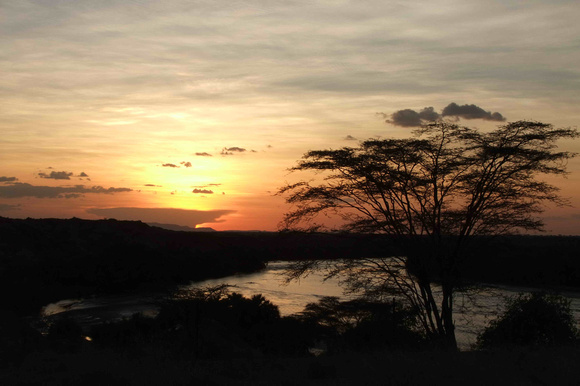
After a successful flight of the Autodesk octo-copter in the late afternoon of the first day, the ground started to cool off as the sun went down. So did our over-excited brains. Yet, a whole new range of challenges were still waiting for us. How to keep logistics going is just one of them.
TBI Turkwel camp is in the middle of nowhere. Being off the grid, the camp’s power supply totally relies on solar batteries and diesel generators. And they could barely satisfy our copter’s heavy demand of power. Our captain Gonzalo Martinez had to keep an eye on all the copter batteries so that they could be charged in shifts. My job was much easier. As our captain ran around the lab round the clock, I had to make sure that he was well hydrated. So I followed wherever he went with a full bottle of water… A firefighter, perhaps…
As night fell, the desert underwent a dramatic transformation: instead of heat, insects dominated the air. And they were everywhere! Where there was light, they gathered! In the lab, in my room, even on my computer screen, swarms of insects of various kinds poured in from far and wide. I was wise to set up a decoy: my flash light pointing to the white wall beside me, just to avoid ending up covered by storms of bugs when I was working on my laptop…
Apart from the frenzy insects, the night was dark and quiet. Thousands of stars shined in the moonless sky, blinking with vigor. The air was so clear and calm that even the reflection of Venus was visible on the wrinkled water of Turkwel River. It was a real pity that such beauty of the night could not be recorded by my camera.
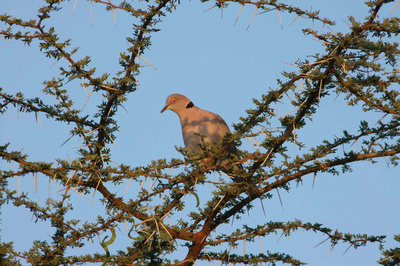
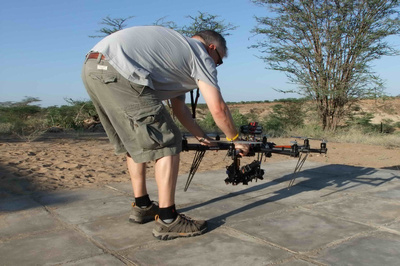
Woken by the first greetings from birds, we started our second day of testing. Why? Well, according to our pilot and mechanic Gonzalo, it was the first time for this machine to fly in such a hot, dry and dusty place. He didn’t even know if it’s going to make it… Should anything happen to it, we still have the chance to sort it out in the camp, which is much better than going to the field with a copter and coming back with a wreck…
The wind was another difficulty for flying in the field. Turkana Basin is generally windy for most of the days and the situation could be worse out in the field. Even though our “spaceship” is well armed with advanced sensors, radio transmitters and fast microchips, whether or not it would hold its ground in strong wind was yet to be tested.
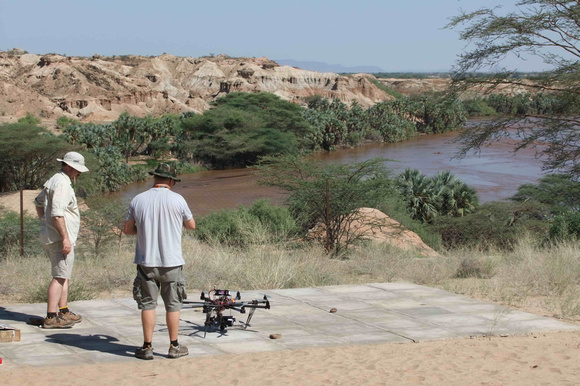
Under moderate wind and temperature, the copter took off! From the monitoring software, all temperature readings from the copter were green, even after some acrobatic performances. Success! The “flying spider” functioned very well in the overwhelming heat!
Now another subject! The magic of this machine is not only about its precise remote controlling, but also its ability of offering LIVE bird’s eye view! It carries a small camera that delivers real-time video from the copter to either a computer screen or a pair of virtual reality goggles. In other words, with the goggles on, our captain could see from the copter as if he were sitting in the copter himself! A bit of Air Force technology! And with these state-of-the-art equipments, the cruising area of the copter could be as large as a circle with its radius of 1000 meters! We could hardly see it when it was really far away!
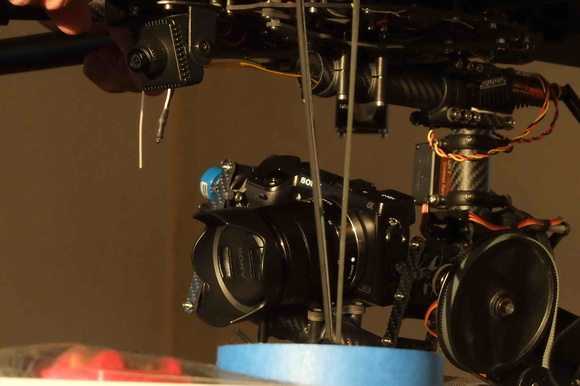
That’s not the end of it! With the capability of carrying yet ANOTHER camera on an articulated frame, and with full remote control solutions, the copter can take detailed aerial photos and full HD videos from almost any angle we want! A Sony NEX-7 with an 18-55mm kit lens did the job perfectly. All these answer the question of how the copter would help us with searching for our ancestral trails: we could send this robotic agent out into corners that have never been visited by men and acquire valuable information from the sky!
When the copter was cruising around the camp, making aerial videos on the way, aboriginals spotted this “secretive” air unit as well. They gathered in small groups, looking at the machine startled, and probably discussed what freak it could be. For people who have minimum exposure to technology in that remote area, seeing such an eccentric (if not supernatural) object in the sky was certainly an astounding or even terrifying experience.
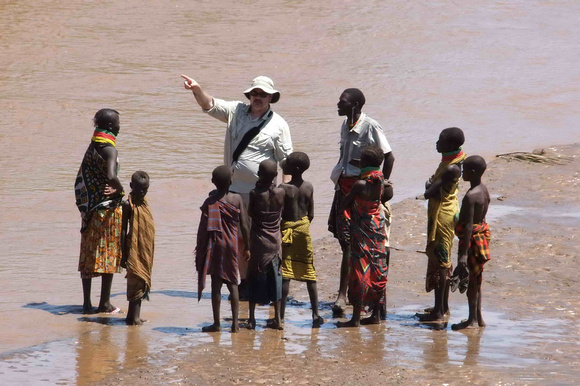
And it was very hard to explain what was going on if they could understand nothing but their local language… (Our photographer and computer engineer Shaan Hurley tried very very hard…)
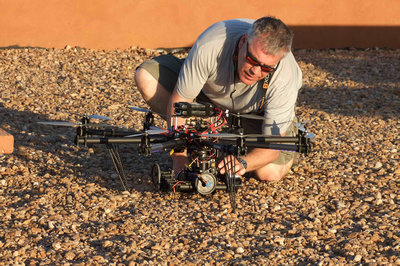
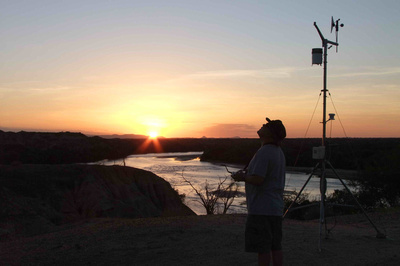
After a few other test flights in the afternoon, our mission of the day came to an end. Looking at the fresh videos capturing the splendid sunset over the camp and the Turkwel River, we were very confident that the copter would do very well in the field operations of the next day! (To be continued)
View and download photos of this post
Aerial video by Gonzalo Martinez, taken from the copter.
]]>However, stories of the past are usually not very well told and many more have never been told at all. They are long lost, buried underground for thousands or even millions of years. Lake Turkana of Kenya is just one of the places with stories waited to be uncovered.
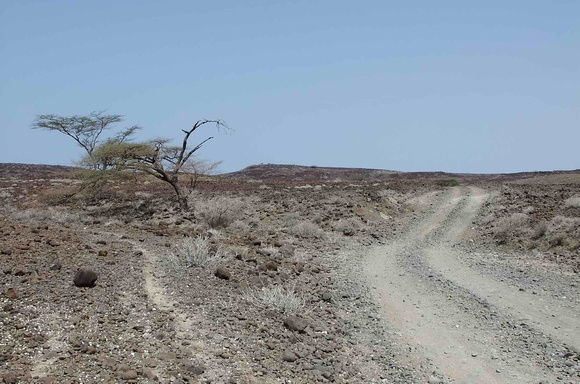
And archaeologists are always ready to go. Since the first discovery of hominid fossils in Lake Turkana region, 1960s, it has been a hot spot for many archaeologists and anthropologists, and indeed it is very HOT there! With day temperature hitting 40 degrees centigrade, the Lake Turkana Basin is situated right in the middle of a desert, where we made our quests in search of our ancestral trails.
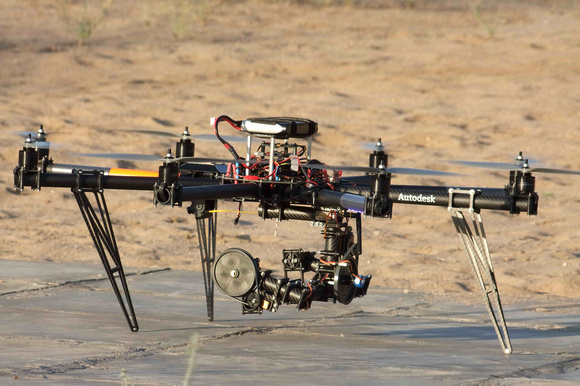
With perils ahead, we still had to carry out our flying missions. We had an intelligent air unit: a state-of-the-art remote controlled eight-propeller Octo-Copter that can hover in the air like a humming bird, cruise in the sky like a hawk, and carry a camera that takes photos and videos. Our goal is to push the limits of new technology, to see how this robotic agent would help us to spot out traces of ancient remains from high up. Our captain, Gonzalo Martinez from Autodesk, is the pilot and mechanic of this ultimate toy. Ground support is from Shaan Hurley, Louise Leakey and myself.
It is always wise to prepare well and to plan ahead for any field trip, since field conditions are highly unpredictable. Our team did very well in that and even brought a spare copter with us! Yet, problems began even before our arrival at Lake Turkana. After the lost and found of a passport, a delayed check-in of a passenger and a series of security checks on our luggage, we finally got on the plane to Lodwar, the largest town to the west of Lake Turkana. It was really hard to convince others that what we were carrying was not a UFO…
As soon as we stepped on the ground of Lodwar, we started to feel the power of the desert: waves of relentless heat stroke us hard, with the dazzling white sun burning our skin. That was what we had to deal with in the following 10 days! It was hard to imagine if any people could ever live there without the life-giving Turkwel River.
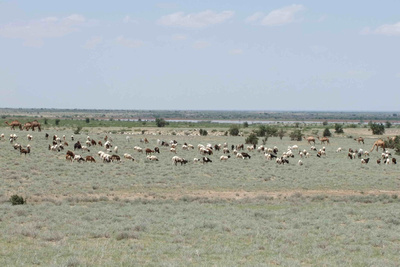
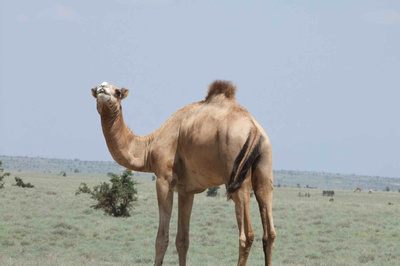
Yet, on the way to the camp of Turkana Basin Institute in Turkwel, we were totally shocked by the vibrant landscapes: vast areas of green grass and shrubs scattered with goats and camels, water holes in various sizes, wild melon vines bearing juicy fruits. Not a desert at all! However, this scene would only be seen at the end of the rainy seasons and certainly for most time of the year, the land is almost barren.
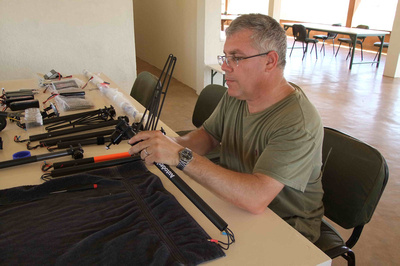
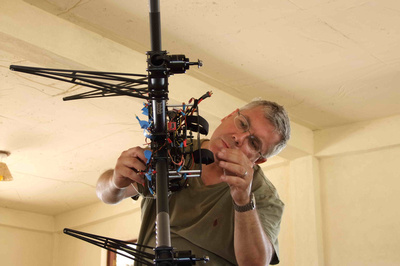
After a couple of hours’ roller-coasting on a Toyota Land Cruiser, we arrived at TBI Turkwel at noon time. Although exhausted by all the traveling and high temperature, our captain Gonzalo started to assemble the copter right after lunch. Still not used to the baking environment even under the roofs, he really struggled to connect all the parts, cables and screws with sweat all over. I greatly admire the meticulous caution our captain took in the two-hour process, as if he was taking care of his own baby.
And the best thing to do in the middle of the day is…
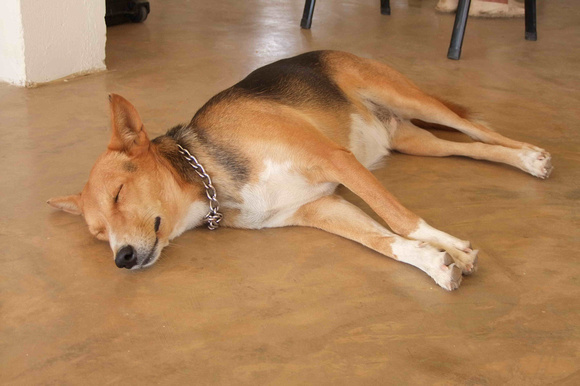
To take a nap… :)
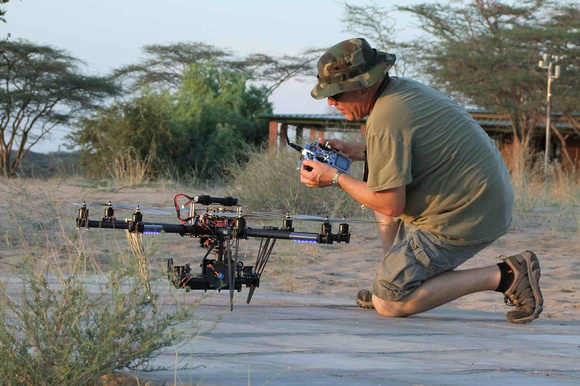
Having overcome weariness, dehydration and overheating of both gears and our brains, we were ready for a test fly! Following the steps of our captain, all ground units were deployed and settled.
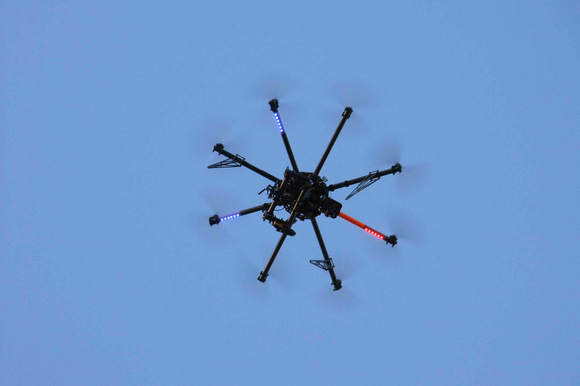 After careful calibrations of all electronic devices and a quick pre-fly check… Up it went! This “flying spider” hovered very well in the air and surprisingly, it could do quick turns, fast climbing and descending! Even ravens were attracted to see its agile performance! Fascinating!
After careful calibrations of all electronic devices and a quick pre-fly check… Up it went! This “flying spider” hovered very well in the air and surprisingly, it could do quick turns, fast climbing and descending! Even ravens were attracted to see its agile performance! Fascinating!
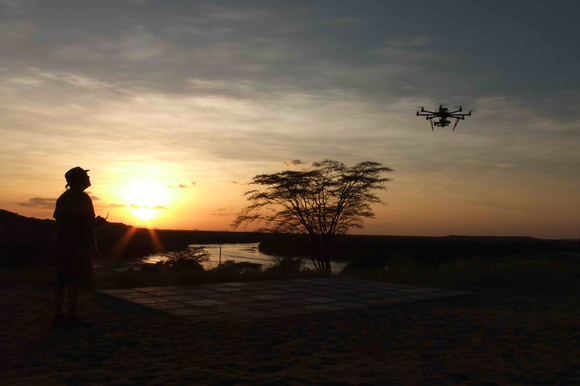 As the sun went down, it was close to the end of our fist flight. Bathing in the soft afternoon sunlight, looking at the splendid sunset with an equally splendid invention in the air, we all came to the same conclusion: what a wonderful flight! (To be continued)
As the sun went down, it was close to the end of our fist flight. Bathing in the soft afternoon sunlight, looking at the splendid sunset with an equally splendid invention in the air, we all came to the same conclusion: what a wonderful flight! (To be continued)
For more information: Blog post by Shaan Hurley, View and download photos of this post
]]>
At a glance, this website may look like a webpage with an interior photo of a paleontology laboratory. In fact, there is a lot to explore!
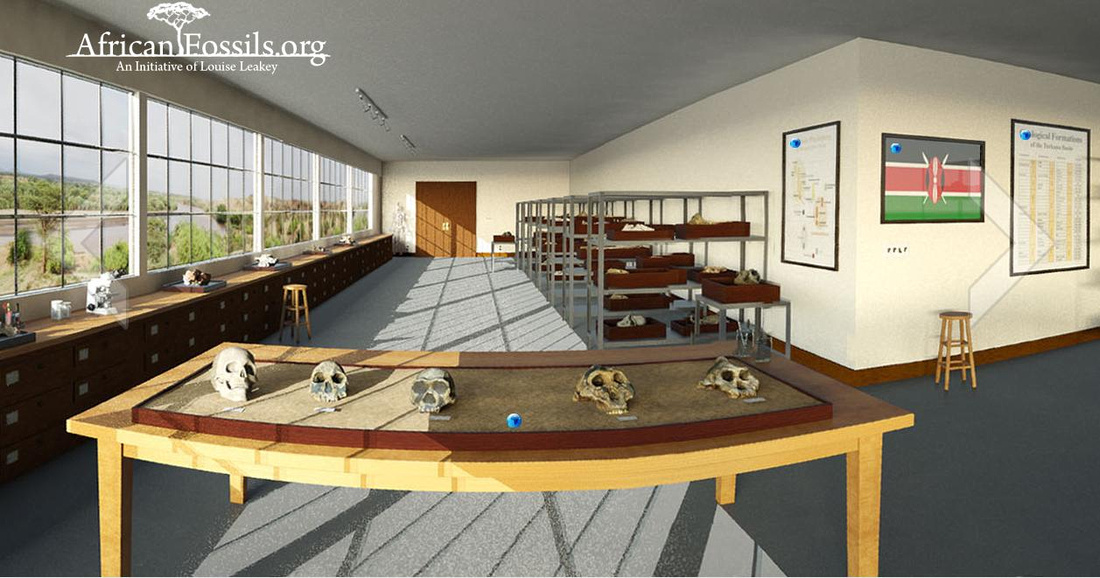
Apart from getting different views of this virtual lab, by clicking on the tables where fossils are on display, you can have a 360 degree free look at its digital collection, including early hominins and various animals that once lived alongside each other. On the walls, there are more secrets than what you might think would be just decorations.
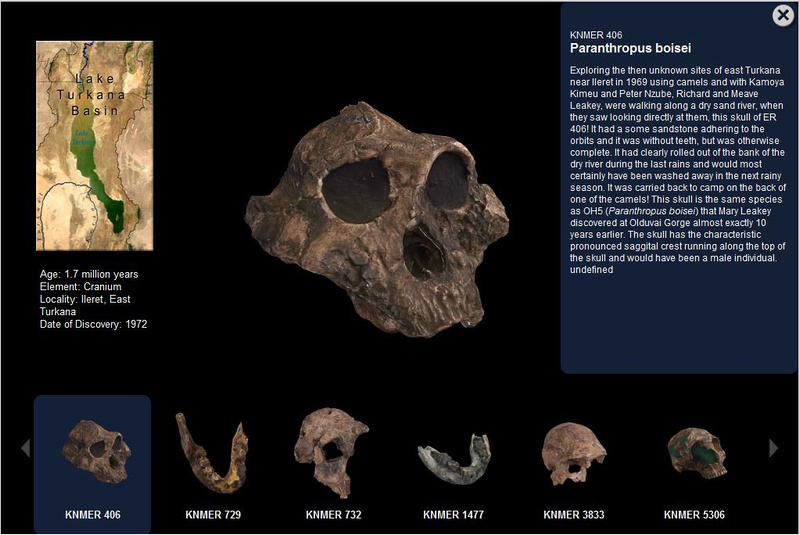
When you are ready to test your talents in identifying bones and fossils, simply click on the tables and follow the instructions on the screen. You will well master how to handle these skulls and mandibles on your computer, by yourself! All the specimens you can see here are built in 3D models and made available to everyone, thanks to our advancing technology. In this fascinated 3D fossil viewer, there is also brief information about every single specimen, such as age, body part and place found. A short story of each of the exhibits is available as well. You might even feel the excitement of the discoverers when they found these amazing pieces in the first place.
This project, aiming at providing educational materials as well as raising public concern, is led by world renowned paleontologist Louise Leakey and supported by Autodesk University and National Geographic. With some of the imaging process done in the National Museums of Kenya, in the real lab of Earth Sciences Department, it is my greatest honor to be part of it. Thank you to all the members of the team. We have done a very good job together. Thank you to my colleagues in the National Museums of Kenya, for your enormous supports of our work.
As the beginning of this project, we have only covered a very small fraction of all the fossil remains resting in National Museums of Kenya and Turkana Basin Institute. In the future, we are going to add more 3D models of fossils to the website, especially those of the fauna. On top of that, we are planning to make more exciting experience available on the website, to make it truly an adventure for users.
For more information, please visit this blog post of Shaan Hurley, our computer engineer from Autodesk.
]]>http://www.tandfonline.com/doi/abs/10.1080/02724634.2012.652324
This formidable ancient predator is named Crocodylus thorbjarnarsoni, with its body length reaching about 7.5 meters, 25 feet! Lurking in the East African waters (Lake Turkana region) between 2-4 million years ago, this monster could be the ultimate nightmare of most animals that drank from lakes and rivers.
According to the article, the new species resembles a man-eating crocodile, the Crocodylus anthropophagus found in Olduvai Gorge, Tanzania. Therefore, the possibility of early hominids rendering preys of the even larger Crocodylus thorbjarnarsoni has been discussed. Although there is no direct evidence that this gigantic creature included early humans in its menu, its enormous size and super-broad jaw certainly allowed it to gulp down adult humans without difficulty! Under the shadow of yet another fatal predator, it was not easy at all for our early ancestors to survive such perils...

Relative sizes of A: Modern human, B: Plio-Pleistocene Australopithecines, C: Largest Nile crocodile, D: Crocodylus thorbjarnarsoni
Modified from C. A. Brochu & G. W. Storrs, Journal of Vertebrate Paleontology, 32:587-602, 2012
Exactly how huge are these colossal ancient crocodiles? With a good representative of fossil individuals housed in the National Museums of Kenya, I had a very close look at their massive skulls and jaws today!
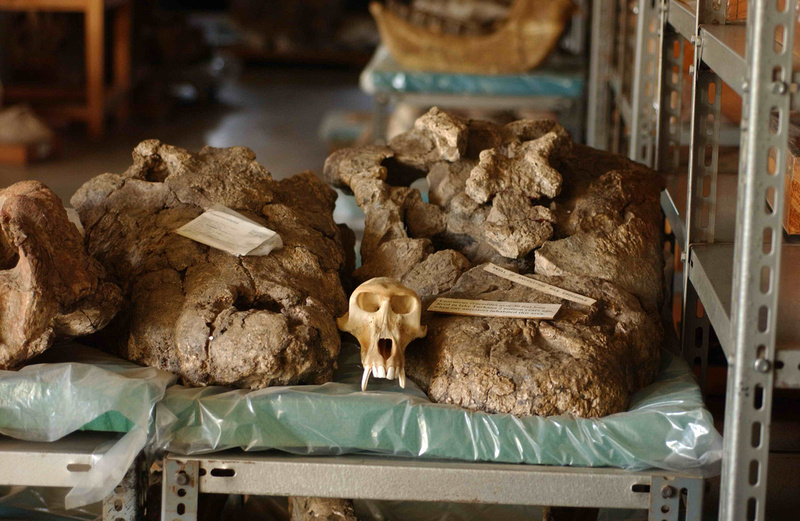
To demonstrate the capability of Crocodylus thorbjarnarsoni tackling on early humans, I put a skull of a male Olive Baboon between two Crocodylus thorbjarnarsoni skulls (facing forward) as a reference. It seems that a baboon would only make a snack of these giant monsters!
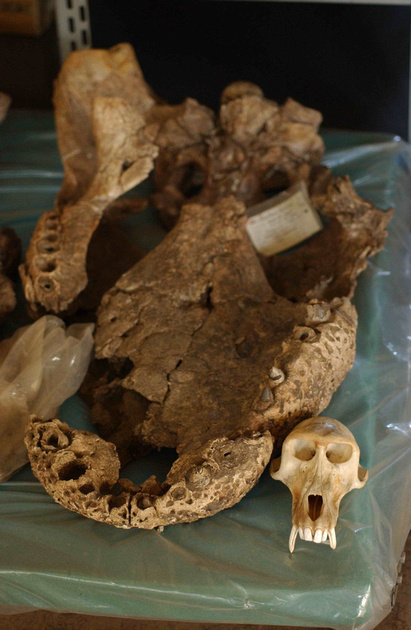
Now the lower jaw! It is clearly seen that the tooth sockets of this crocodile are about the same size of the baboon's eye sockets! I will not be surprised if ancient human remains are found carrying tooth marks of these huge crocodiles.
The most recently found specimen, a complete cranium together with a mandible, was discovered by the Koobi Fora Research Project in 2009 in the Lake Turkana region. The initial field report is written by Lawrence Nzuve, my friend who works in the Turkana Basin Institute.
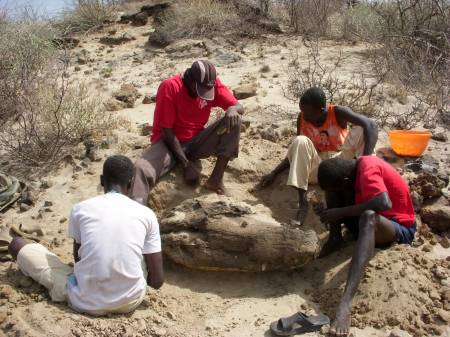
Courtesy of Koobi Fora Research Project, taken by Lawrence Nzuve
Being 7.5 meters long, the Crocodylus thorbjarnarsoni dwarfs any of the living crocodiles on this planet. What could have driven these ancient giants to extinction is still to be revealed.
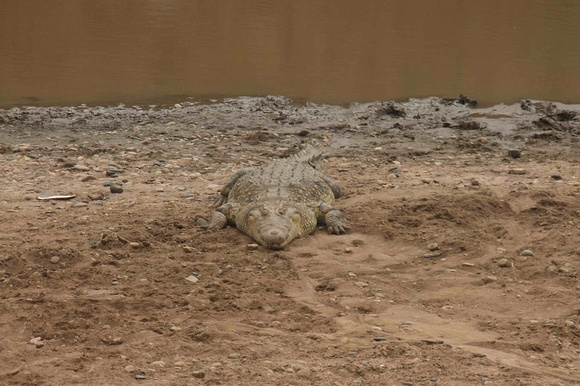
A Nile Crocodile (Crocodylus niloticus) found on the bank of the Mara River.
"Alas! Man-eating crocs! Well done, my brothers!"
]]>]]>
